Announcements
REMINDER: Sign up for the Foundry Newsletter to receive a summary of new products, features, and improvements across the platform directly to your inbox. For more information on how to subscribe, see the Foundry Newsletter and Product Feedback channels announcement.
Share your thoughts about these announcements in our Developer Community Forum ↗.
Introducing the ability to power AIP Assist with your custom documentation
Date published: 2024-05-29
You can now equip AIP Assist with your personal documentation, allowing it to supply users with information as needed. Starting the week of May 27 across AIP-enabled enrollments, configuration options to make AIP Assist aware of your custom operational documentation is available in Control Panel. This feature includes the ability to centrally manage when Assist can access the documentation, which documentation, and whether to limit referencing to when a user is viewing certain resources. By allowing AIP Assist to respond to user questions on how to interact with operational workflows as well as how to navigate the platform, you can improve the ease of user onboarding to your workflows.
Information that you can allow your assist to share may include program documentation, standard operating procedures (SOP), and wiki-inspired information, such as data ingestion processes, procedures for requesting permissions, best practices for organizing projects, and general information. More focused documentation, like use case and workflow documents, can be particularly beneficial for user onboarding, training sessions, and promoting general self-service and usability. Learn more.
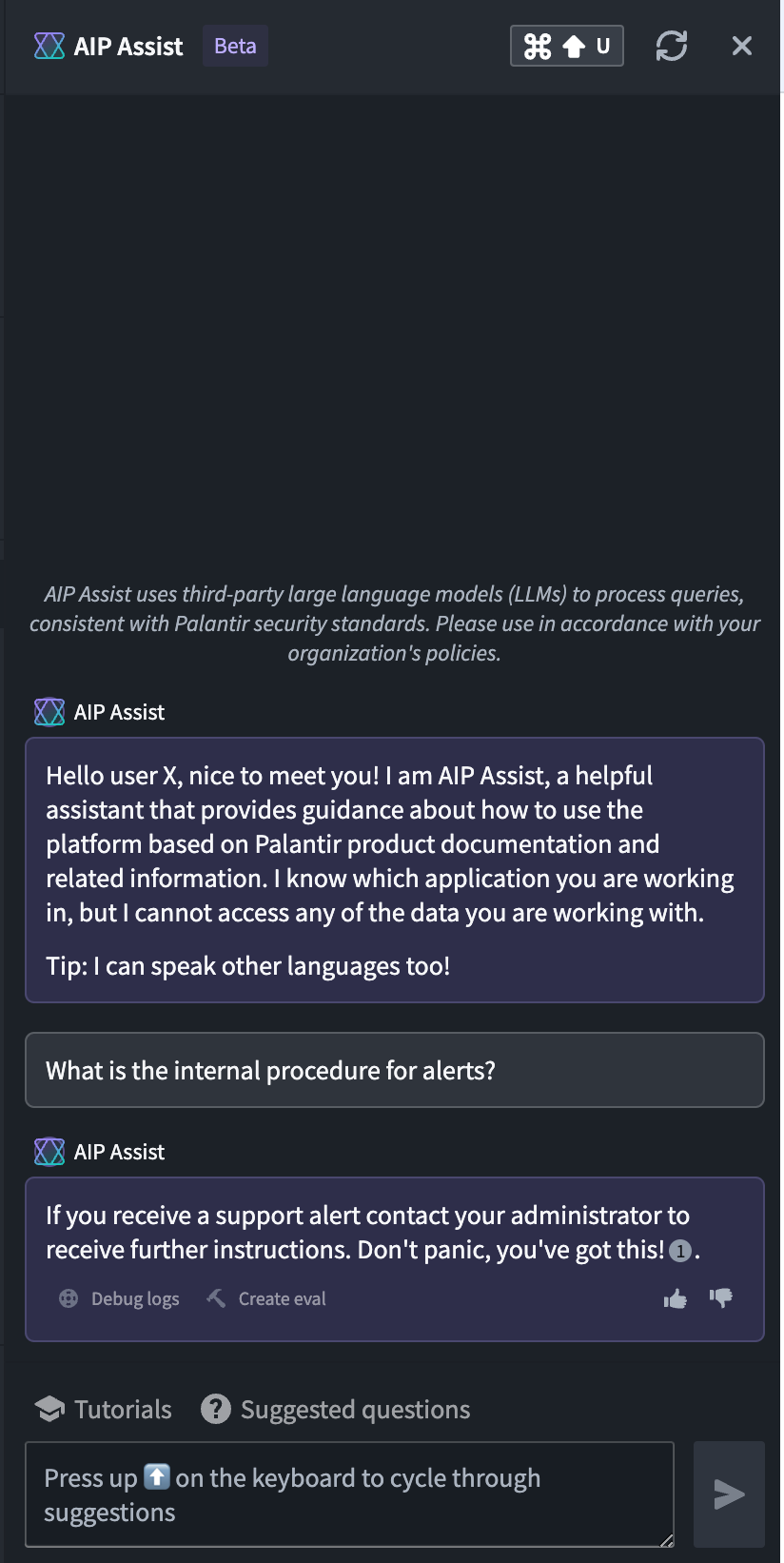
Empower AIP Assist with your custom documentation to further customize Assist's ability in answering program and use-case documentation relevant for your operations.
To start, enable access to your documentation repository
To leverage this capability, you must already have custom docs in a Documentation repository within your Code Repositories. Contact your Palantir representative to enable documentation type repository if not available, and if already setup, to whitelist the repository after creation. To fully manage the scope of the documentation beyond the documentation source, you must also have permission to use Control Panel.
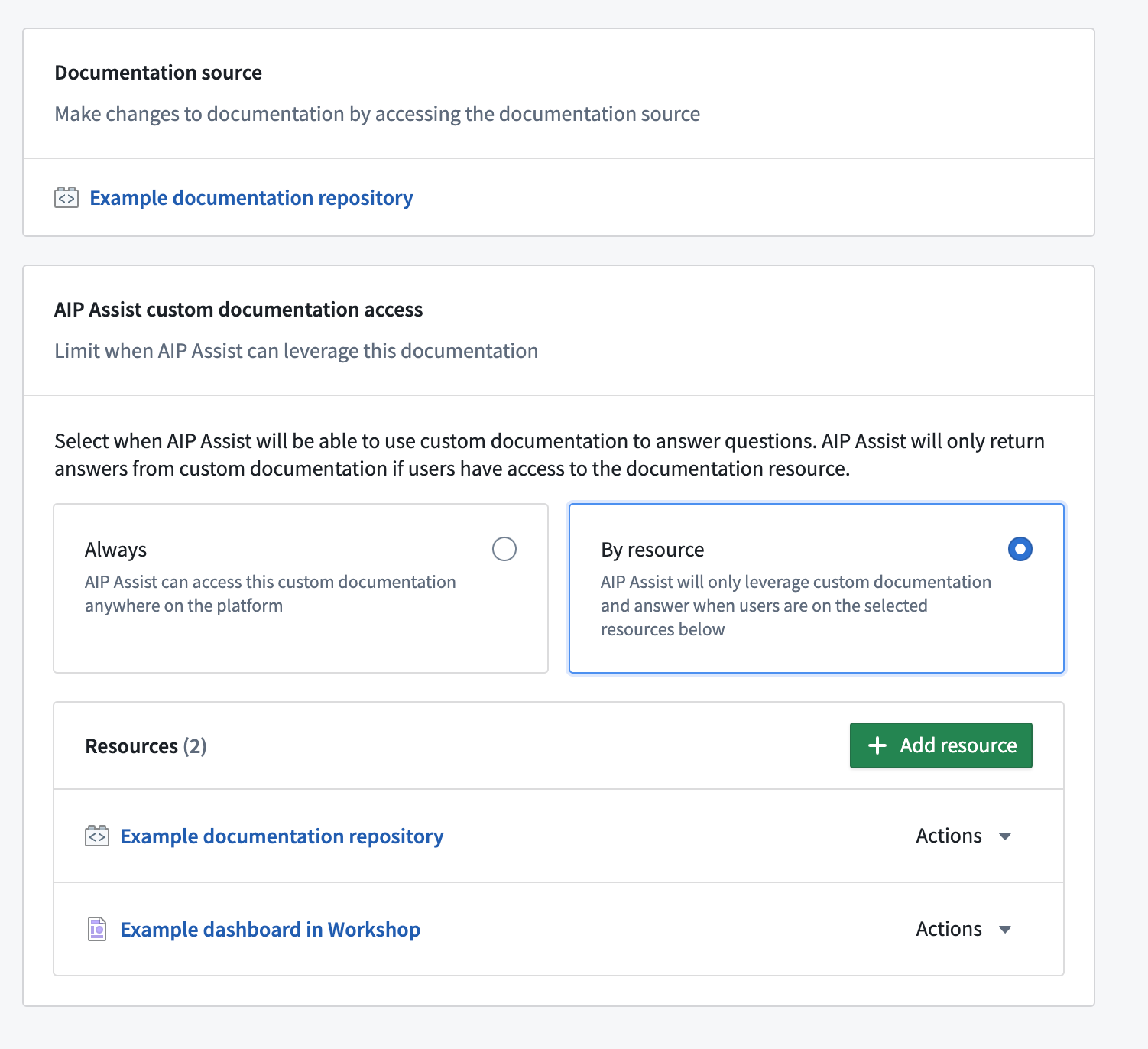
Manage when AIP Assist can access the documentation to answer a user question. Set to "always available" or "by resource" for more granular control.
For more, review the AIP Assist Custom Documentation guide.
Spark 3.5.1 Upgrade
Date published: 2024-05-29
The version of Spark used in Foundry transforms is being upgraded from 3.4.1 to 3.5.1. This brings a plethora of bug fixes, performance improvements, and new features that can be viewed on the release page ↗. No action is required to enable this upgrade. The transforms runtime versions are managed automatically in the background through adjudication, as per the transforms versions docs.
The Spark versioning policy ↗ disallows the introduction of API and behavior changes between minor versions. Any changes are documented in the migration guide ↗, which has been tested by Palantir to ensure the user experience remains constant.
It is possible for upgrades to affect the performance of pipelines and introduce new bugs. For high-risk jobs, use a temporary pin to control the upgrade rollout until you have confirmed the upgrade to be issue-free for your workflows.
Introducing object type groups in the Ontology
Date published: 2024-05-29
Rather than tagging objects directly, builders can now utilize a fully-featured Ontology primitive called groups to classify object types. Groups make it easier to search for objects and improve the legibility of complex Ontologies.
New group features
Group metadata can now be modified from the new Groups menu, accessible from the left-hand navigation bar in Ontology Manager. In addition, all groups will now be discoverable to any user that can view the Ontology. This change aligns group visibility with other Ontology primitives to increase clarity and transparency in governance.
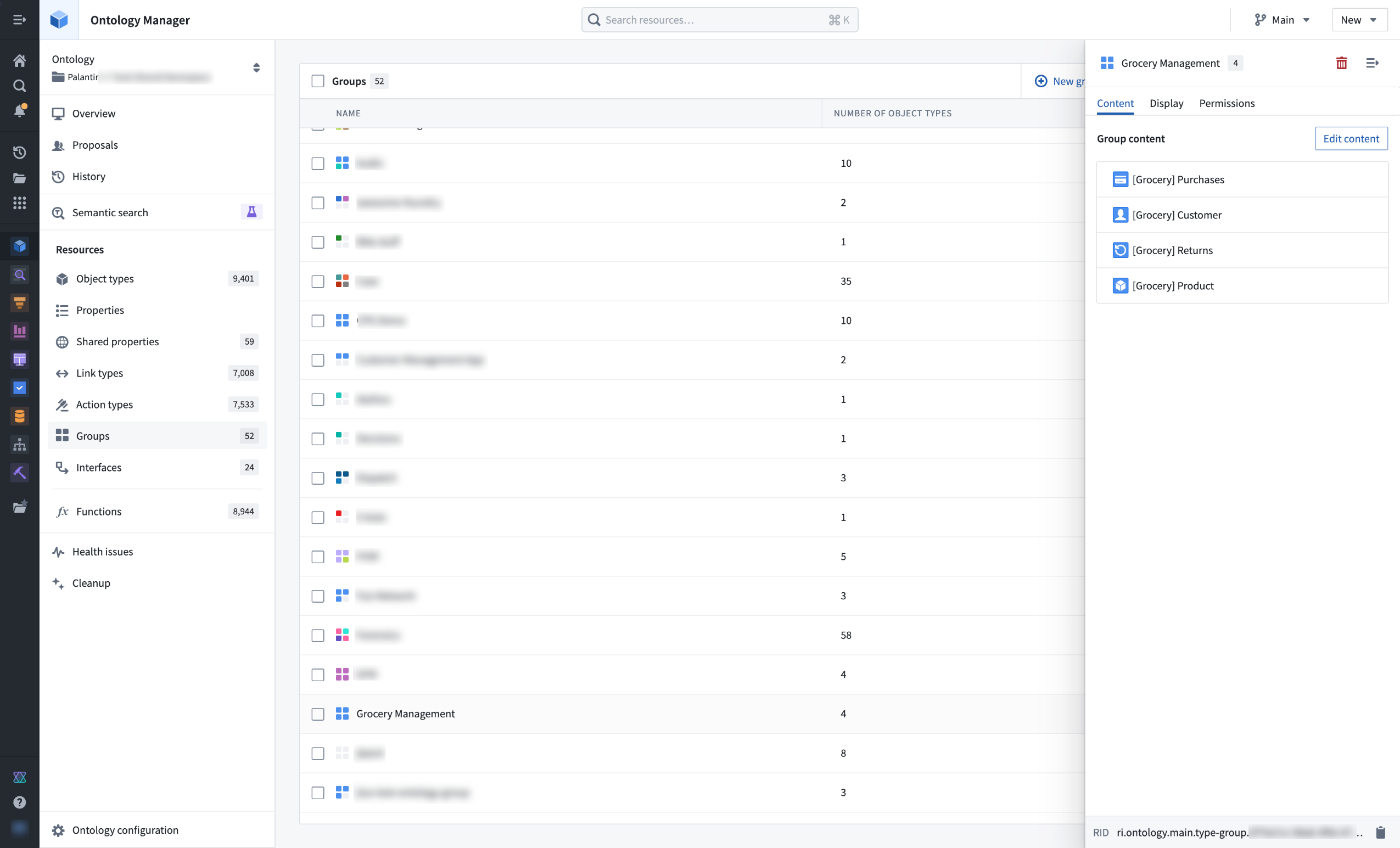
View and modify object type groups from the Ontology Manager.
Groups can be added or removed as part of object type configuration in Ontology Manager. Groups are also searchable and filterable in Ontology Manager, and are used in the Object Explorer Overview page to categorize object types.
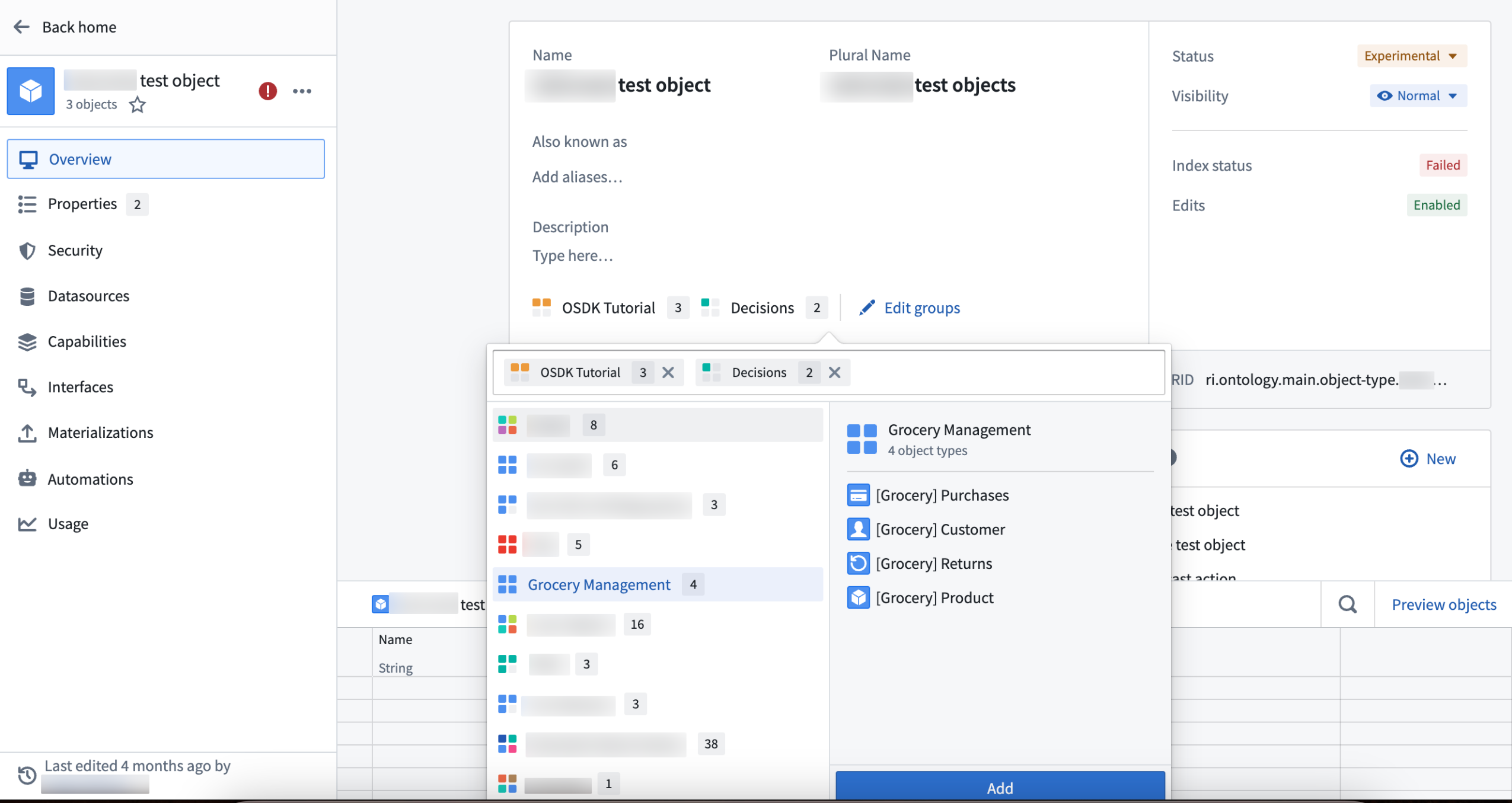
Add groups as part of object type configuration.
Legacy groups
Some legacy groups were not eligible for automatic migration. In these cases, Ontology owners were notified via an Upgrade Assistant intervention that manual action was necessary.
As of May 22, 2024, legacy groups that could not be safely migrated were hidden from operational users across all applications such as Workshop and Object Explorer. To provide backward compatibility, the names of legacy groups remain stored as type class metadata on object types.
Ontology owners may continue to manually migrate these hidden, legacy groups using Ontology Manager. To do this, navigate to the Ontology Configuration menu in the bottom left corner and select Approve all Groups for migration.
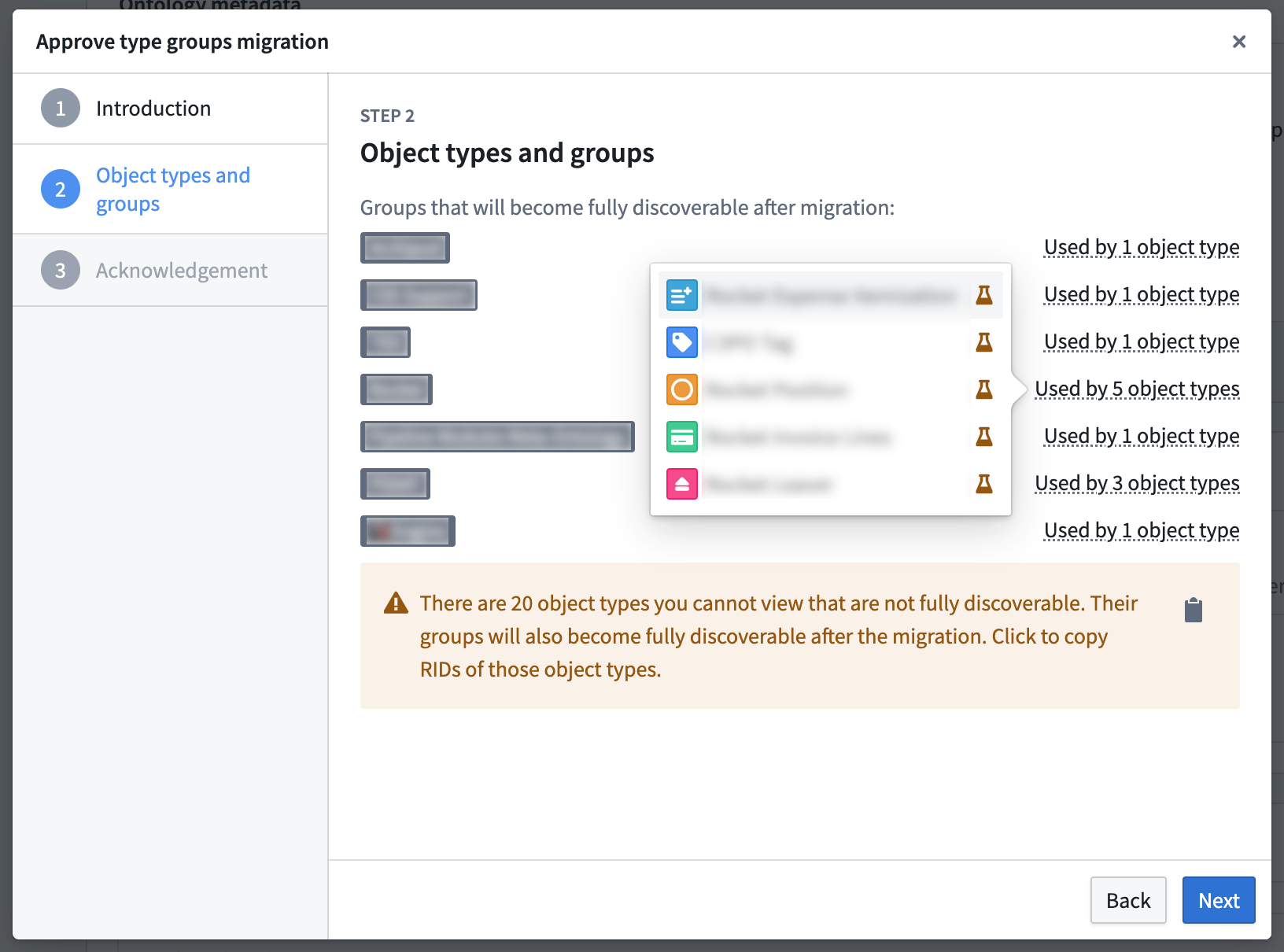
Some legacy groups require manual migration to unlock new features.
Pipeline Builder now supports outputting errors in your LLM runs
Date published: 2024-05-23
You can now configure your LLM output column to contain both the output value and an error message if the row fails, offering easier debugging for LLM-related issues. With this feature, you receive both the LLM response and error message as a struct in your output column. This transparency into LLM errors makes it easier to debug processing issues and understand what is happening behind the scenes with your model. Example error messages may include:
- "Context limit exceeded"
- "Cannot coerce to provided output type"
- "Input prompt is null or empty"

Example of an LLM prompt configured to include errors.
To use this feature:
- In Pipeline Builder, open a Use LLM node and create a prompt.
- Locate the Output type section.
- Toggle on the Include errors checkbox.
When including LLM error messages, the node output will be a struct type, containing both the regular output value (which can be any supported output type, including a struct) and the associated error message.
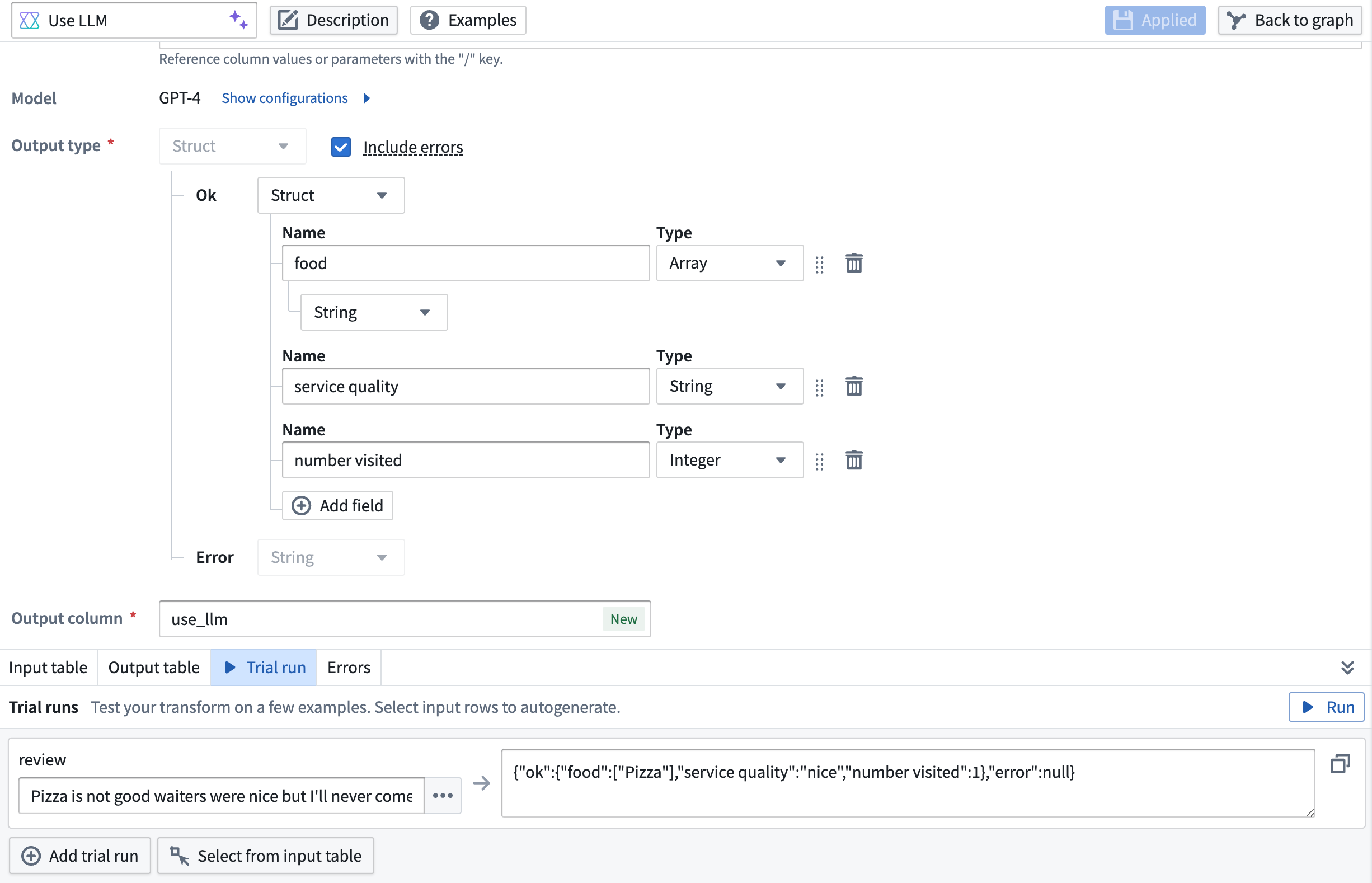
Example of a struct output type (containing an array, a string, and an integer) with the included error message.
You can easily switch this feature on or off for flexible error transparency control by deselecting the Include errors box.
Learn more about using LLMs in Pipeline Builder from our documentation.
Introducing Pages and Shared Variables in Slate
Date published: 2024-05-23
Pages offer application builders the ability to split application UI, logic and resources (data, variables, functions, events) into different pages within a single application, providing isolated scope for each page that loads separately, including widgets, functions, queries, and more. Additionally, you now have a more nuanced control of variables, being able to configure them by page scope, "local" and "shared", with shared variables being accessible from any page, thereby enhancing application design, performance, and user experience.
Speed up app loading time
A common pattern for splitting a Palantir Slate application into multiple views is to use a tabbed container. However, this approach may lead to very large page loads, limit the level of control developers have over loading data, and present widget maintainability and organizational challenges due to having a single list of components and widgets.
Switching from tabbed containers to pages allows larger applications to load information more quickly, as they only load data relevant to each page's specific scope.
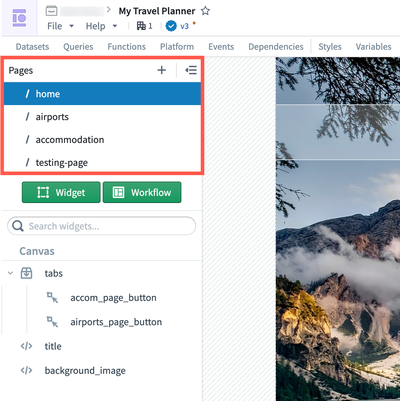
Multiple pages can now be built in a single Slate application.
This approach enables the scoping of application logical flows into individual pages with meaningfully named URL routes. Additionally, page names can be used in the URL to navigate to the page directly when sharing a link into a Slate application.

Application logical flows can now be scoped into individual pages with meaningfully named URLs.
Increase application stability
Splitting up the logic of a complex Slate application into pages also simplifies refactoring, resulting in improved maintainability and performance.
Seamless navigation between pages
The new onNavigate event and navigateTo action allow for simple navigation actions between pages within the same application. Navigating to a page will update the URL route to point to the target page.
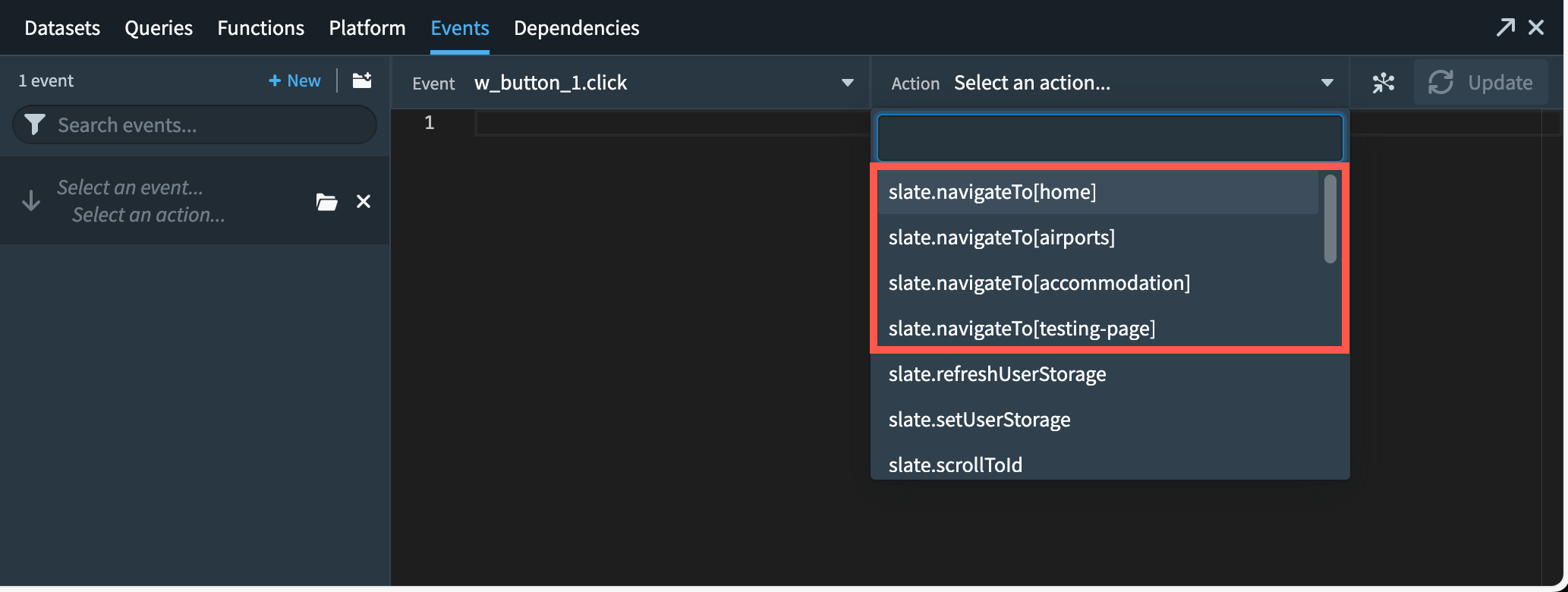
Navigation to a page will update the URL route to point to target page.
Sharing application state between pages
New Shared variables are accessible from any Slate page, allowing for an application level state sharing across pages.
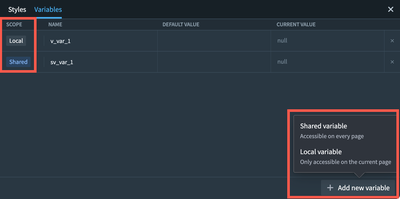
For more on Slate, review the documentation on Slate application Pages.
Introducing conflict resolution strategies for Ontology user edits and datasource updates [GA]
Date published: 2024-05-23
Object instances in the Foundry Ontology can be created and modified by both input datasources and user edits. When a single object instance, such as a row or object with a specific primary key value, receives data from both the input datasource and user edits, these received values must be transparently resolved with a conflict resolution strategy.
You can configure conflict resolution strategies at the object type level. Select an object type in Ontology Manager and navigate to the Datasources section.
Note that conflict resolution strategies are only supported for Object Storage V2 object types.
Conflict resolution strategies
There are two conflict resolution strategies for Ontology edits:
- Apply user edits (default): With this strategy, the final state of an object instance is always determined by the user edits applied to it, regardless of any future datasource updates for the given object instance.
- Apply most recent value (limited beta): With this strategy, user edits are only applied if the timestamp value of the user edit is more recent than the timestamp value of the datasource update for the given object instance.
This strategy also requires that the datasource contains a property with the Timestamp type; the Date property type will not work for this option. The Timestamp property is used to evaluate whether a user edit or input datasource update should be applied.
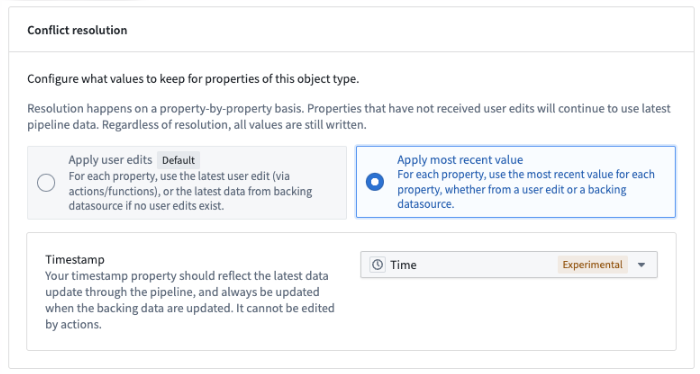
Configure conflict resolution strategies in Ontology Manager.
Configure different resolution strategies for multiple datasources
You can configure different conflict resolution strategies for each input datasource of the object type. For example, for an object type backed by two datasources, you can configure one datasource to use the Apply user edits strategy and the other datasource to use the Apply most recent value strategy.
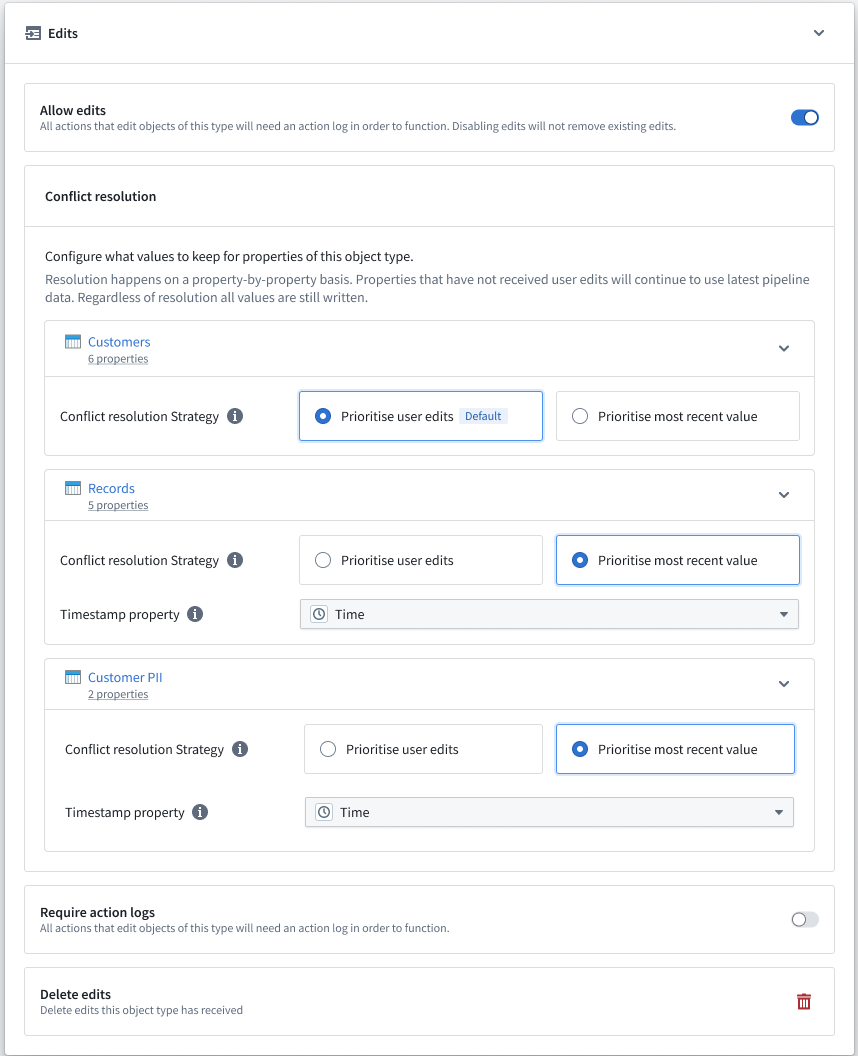
Configure conflict resolution strategies for multiple datasources in Ontology Manager.
If a user edit updates properties across multiple datasources, Ontology Manager will determine whether to always apply or conditionally apply the edits using the conflict resolution strategy of the datasource that backs the property.
Learn more about how user edits are applied.
Introducing Quick Start in Code Repository
Date published: 2024-05-23
Available now on all enrollments, Code Repositories can now guide your repository setup via an intuitive quick start discovery and navigation interface. Selecting the ideal code-based workflow for development can be difficult, but this user-friendly quick start interface simplifies the process. Forget about sifting through extensive documentation; just answer three quick questions or search for your repository type, such as "Python transforms," to effortlessly set up your repository with examples and READMEs to steer your development journey.
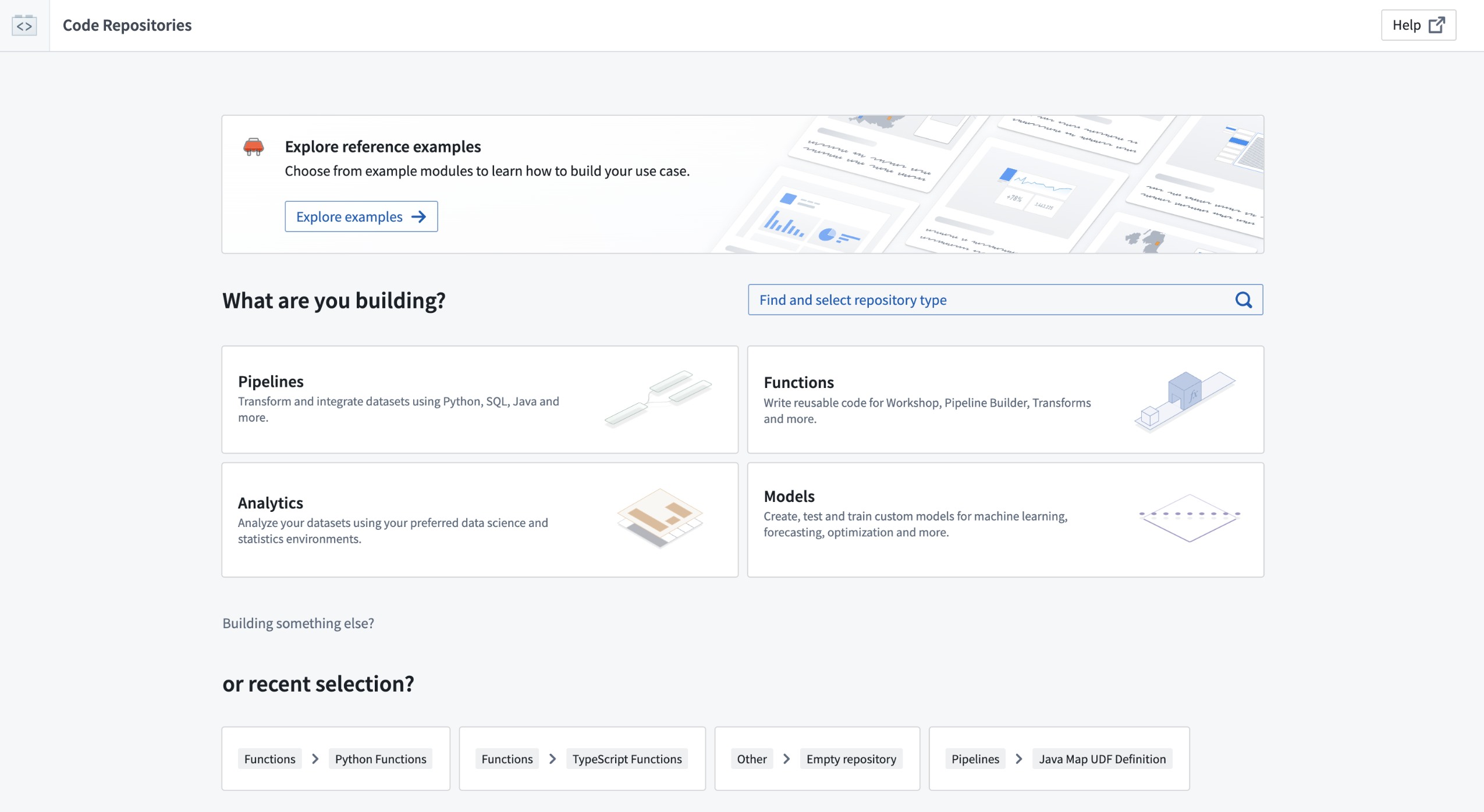
Quick start page for Code Repositories.
Intuitively view, select, and discover workflows
Quick start empowers application builders to:
- View all the code-based workflows available in the Palantir platform.
- Select the right template for your workflow.
- Discover reference examples from Marketplace.
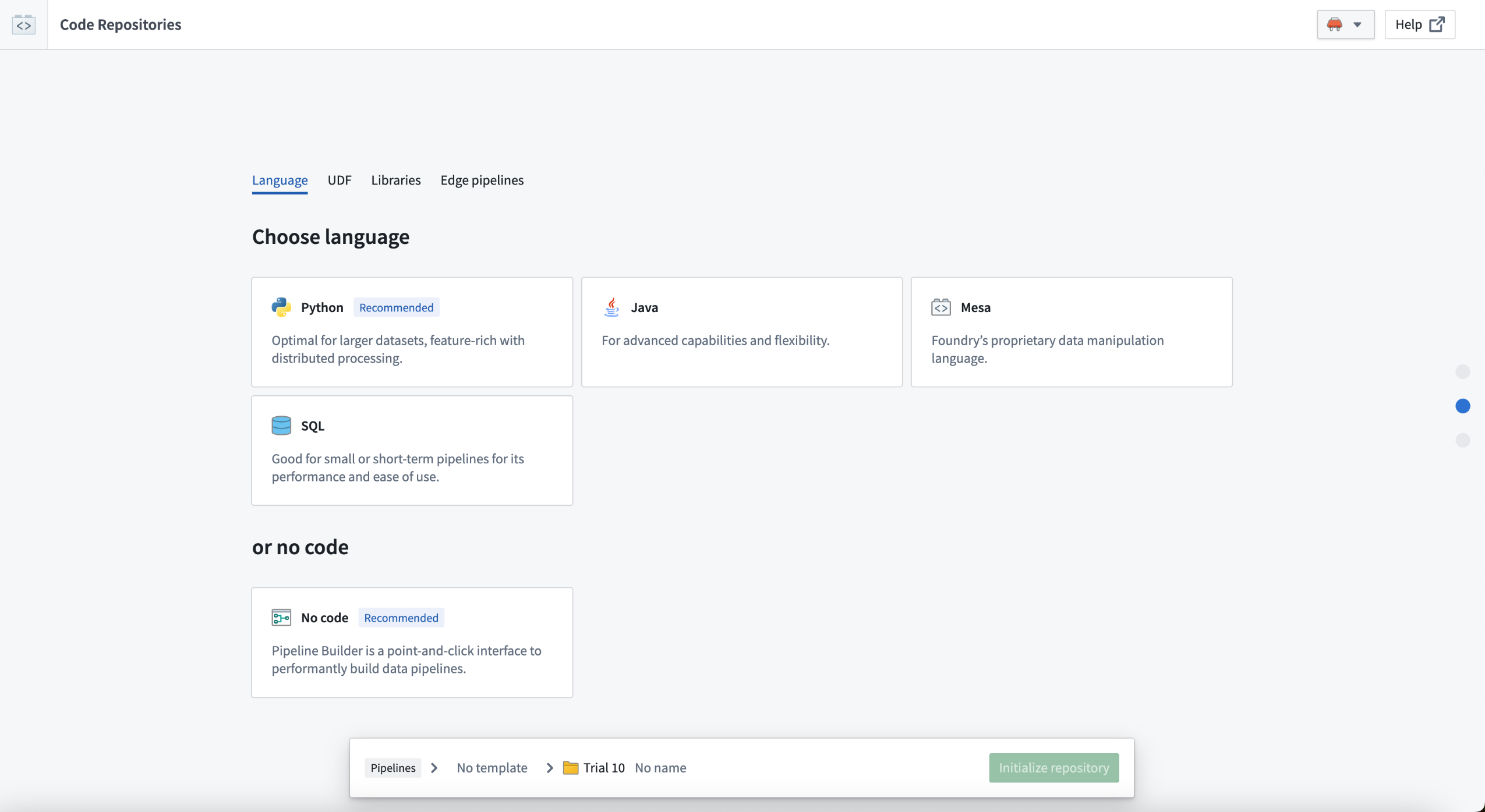
Answer just three questions to receive recommendations and examples for your repository.
What's next on the development roadmap?
We are actively developing new functionalities and templates, while creating more reference examples for Marketplace.
Introducing AIP Accelerate [Beta], your notebook environment for LLM workflows.
Date published: 2024-05-21
AIP Accelerate is a notebook environment for building large language model (LLM) powered workflows. Available the week of June 3 across enrollments, AIP Accelerate enables you to rapidly iterate on LLM prompts that leverage your data in various forms, whether it is a dataset imported from Foundry, or a file on your computer. With AIP Accelerate’s provided library of LLM operations, you can build complex chains of thought, interpret uploaded images, and generate LLM-powered insights. With support for the latest generative AI models, AIP Accelerate is a sandbox for wielding the capabilities of LLMs for investigative business workflows.
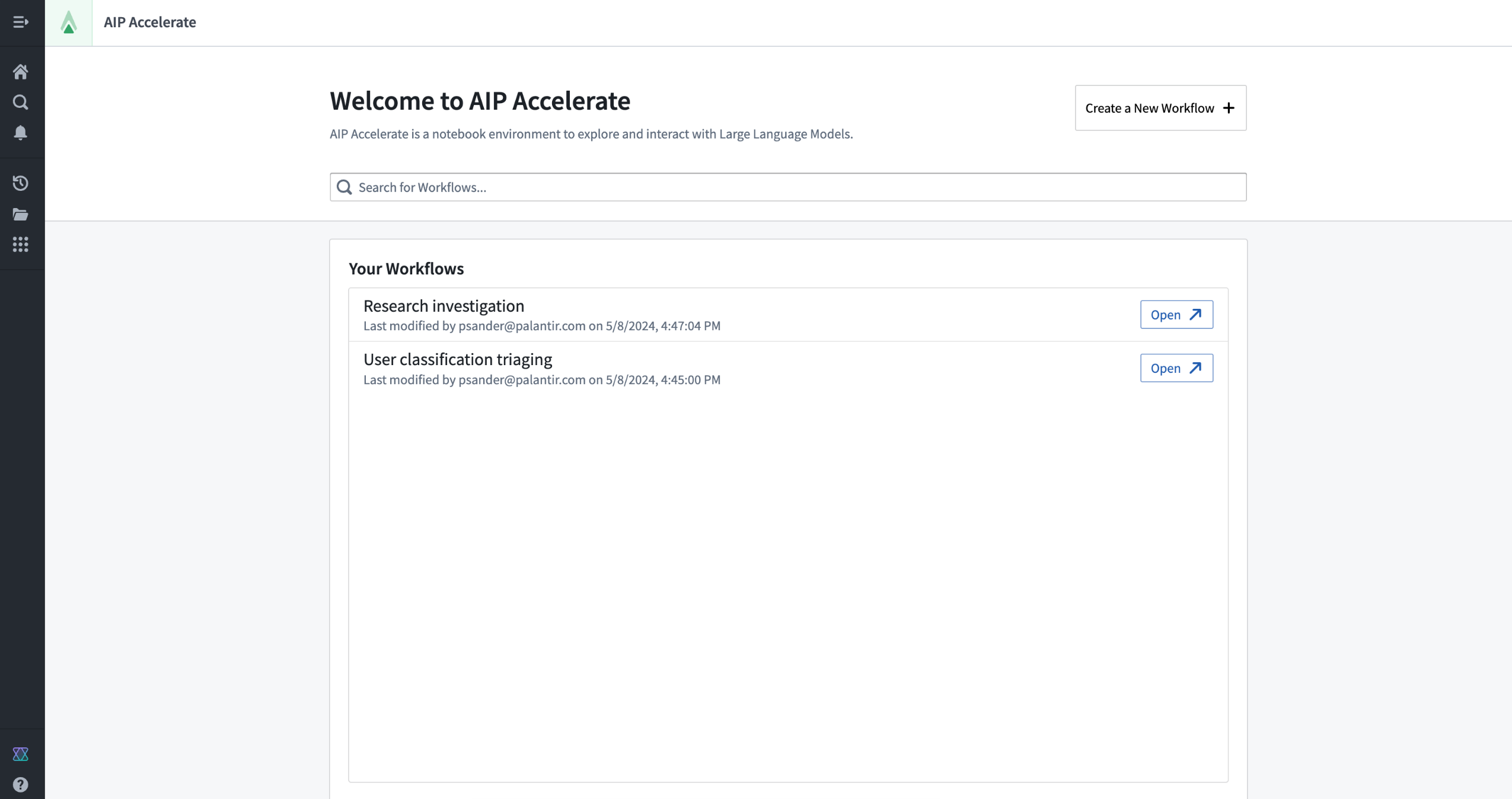
AIP Accelerate landing page.
A LLM's response effectiveness highly depends on the contextual environment. AIP Accelerate enables you to carefully manage what context the LLM is given by using Context Threads. Context threads are one of the primary components of Accelerate, and denote a chain of information that is provided to a large language model. Cells pass information downward, via a context thread, to their sub-cells. Workflow builders can use context threads to break out of the linear-chat motif and engineer workflows that are not limited by a single context path. Furthermore, AIP Accelerate leverages primitives within the platform to enable operations on various forms of structured and unstructured data (such as tabular data, PDF, or image files) to do complex analysis.
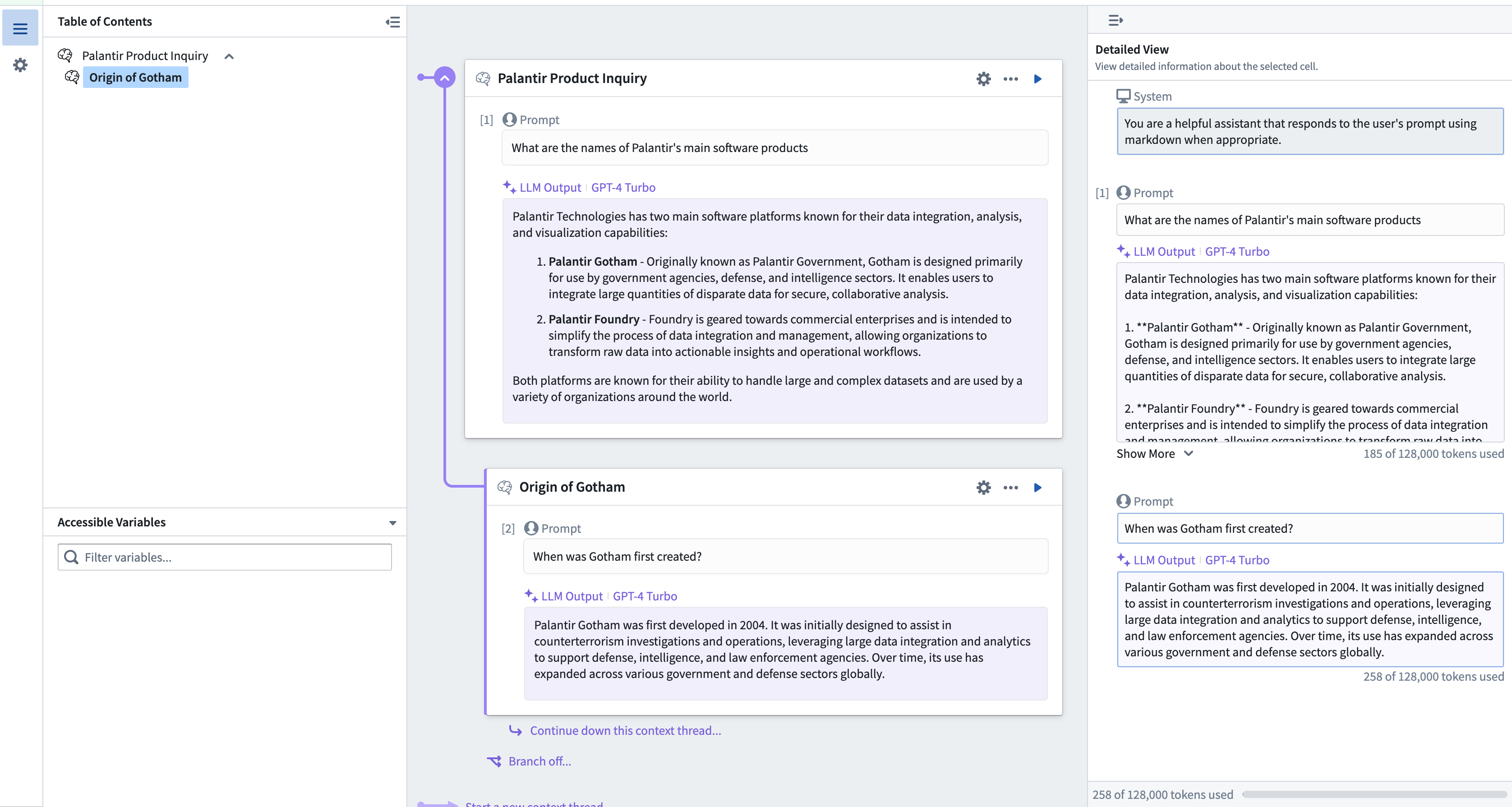
AIP Accelerate context thread where the child LLM cell inherits the context of its parent, continuing the conversation.
In the image above, we have a two-cell context thread. We can continue nesting cells to drill into a conversation with an LLM, or branch off after any cell and go down a different path.
Secure and customizable AI-powered analysis
The key features of AIP Accelerate include:
- User-friendly interface: AIP Accelerate has an intuitive interface that makes it easy for workflow builders to construct complex, multi-dimensional analysis using LLMs.
- Generative AI models: Customize which available LLMs to use when executing both text and vision based tasks.
- Operate on real data: Deploy LLMs over data within the platform such as datasets or mediasets (images or PDF documents).
- Share results: Save analysis results as a new dataset for use in other AIP tools or share a workflow with other users.
- Data security: AIP Accelerate is built on the same rigorous security model that governs the rest of the Palantir platform, including user based data permissions. These platform security controls grant an LLM access only to what is necessary to complete a task.
AIP Accelerate is under active development and support for more operations are coming soon.
Access AIP Accelerate
AIP Accelerate can be accessed from the platform’s workspace navigation bar or by using the quick search shortcuts CMD + J (macOS) or CTRL + J (Windows). Alternatively, you can create a new workflow from your Files by selecting +New and then choosing Accelerate, as shown below.
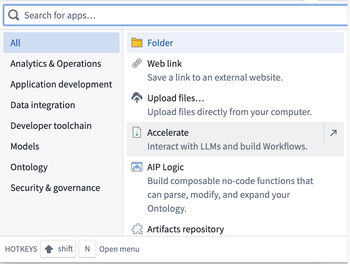
The Foundry app navigation menu.
Introducing new features for an improved code experience in AIP Assist
Date published: 2024-05-15
We are excited to introduce two new features in AIP Assist that improve the developer experience and increase efficiency. The new code tool helps answer complex coding questions, and a TypeScript compiler is now in use to improve TypeScript code and flag issues with initially proposed code. This is now available on all enrollments.
Get accurate, Palantir-specific code
With the new AIP Assist code tool, we are now able to return answers with accurate, Palantir-specific code for several applications and features. For example, you can ask an Ontology-focused question ("how can I write an Ontology edit function?"), or ask about a specific language ("how can I parse raw files in parallel in a Python transform?"). Previously, AIP Assist could provide answers using generic, non-Palantir code that presented general use cases. With these improvements, developers will be able to receive accurate, specific code that directly supports their workflow in Code Repositories.
On introduction, the code tool in AIP Assist supports the following languages:
- Python
- TypeScript
- SQL
- PySpark
- Contour expression language
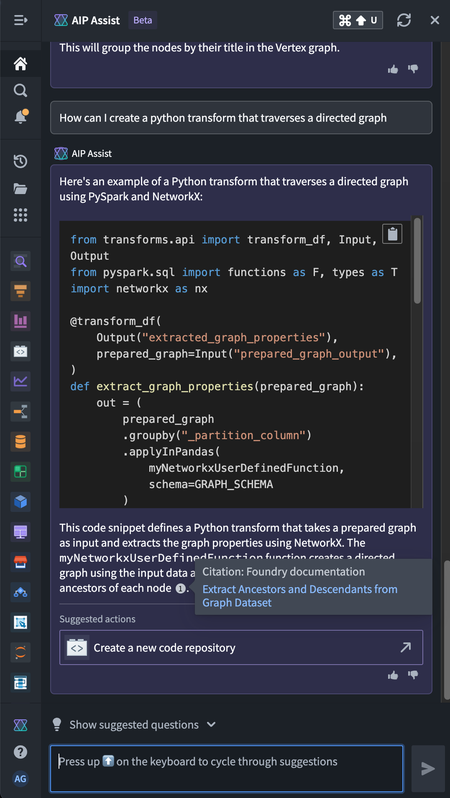
The new code tool improves code responses in AIP Assist.
The new code tool will continue to improve the developer experience in AIP Assist as Palantir engineers update and expand our collections of code examples; the examples, now available in our documentation, will provide use case guidance and inspiration for solving complex problems and transformations.
Fix compiler errors in the moment
AIP Assist is now also integrated with the TypeScript compiler to flag issue with type mismatches, unhandled promises, and more. Once AIP Assist generates an initial code in response to questions, the code will pass through the compiler to find errors and allow users to commit changes directly in the Assist interface.
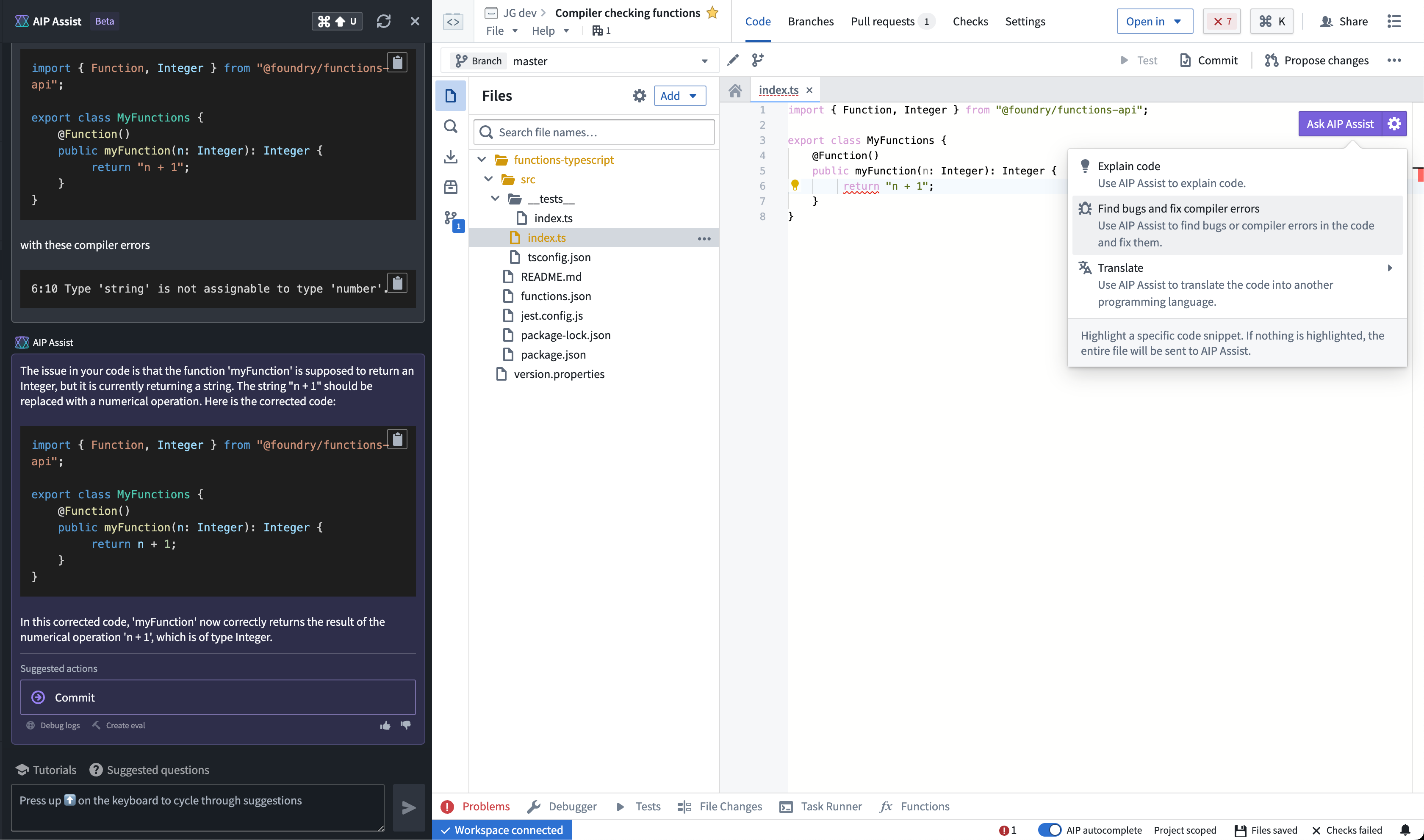
Compile Typescript errors directly in AIP Assist.
As the TypeScript compiler works, AIP Assist receives feedback that iteratively refines the generated code. The compiler adjusts types, adds missing type definitions, corrects promise handling, and ensures the code adheres to TypeScript's strict typing. Each iteration is re-checked by the compiler until the code compiles without errors.
AIP Assist not only solves immediate problems with code, but also provides insight into developers on how to avoid similar issues in the future.
Learn more about the AIP features you can use to improve your developer experience.
Pipeline Builder now supports enforced output types for LLM nodes
Date published: 2024-05-15
You can now specify the output types of your Use LLM nodes in Pipeline Builder! These functionalities ensure consistent output types, enhancing your ability to maintain data type consistency and optimize data processing within your pipelines.
How to enforce output type in the Use LLM node:
- Ensure that your Foundry frontend instance is updated to v6.321.0 or higher.
- Add a
Use LLMnode to your pipeline. If you use a template, submit the template first to get to the prompt page. - On the prompt screen, locate the Output type field and select the desired output type from the dropdown menu.
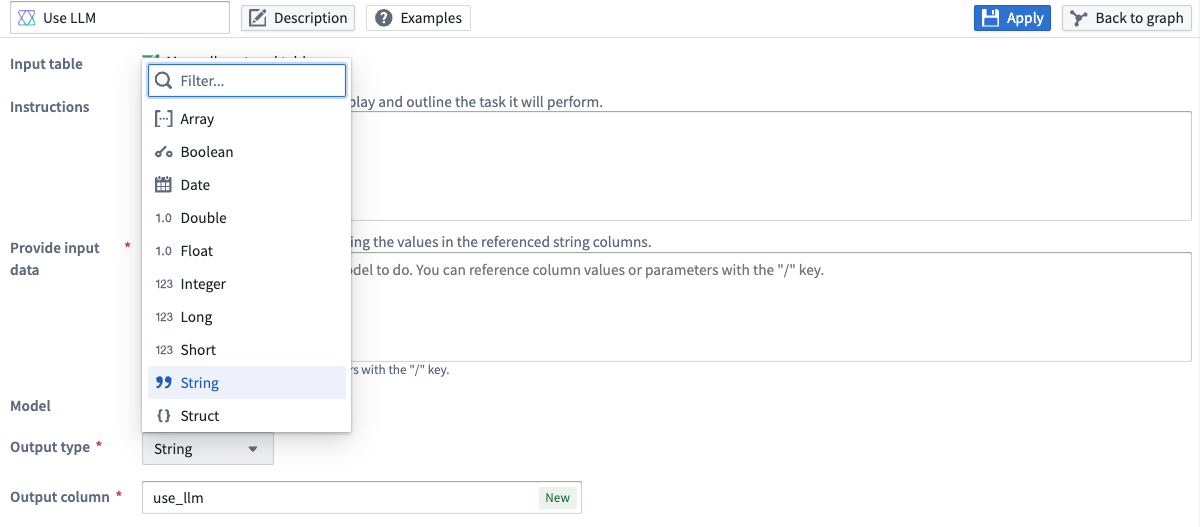
Use the dropdown menu to specify an output type for your Use LLM node.
For entity extraction, you can also specify the output types inside a struct to provide more flexibility and control over your data outputs.
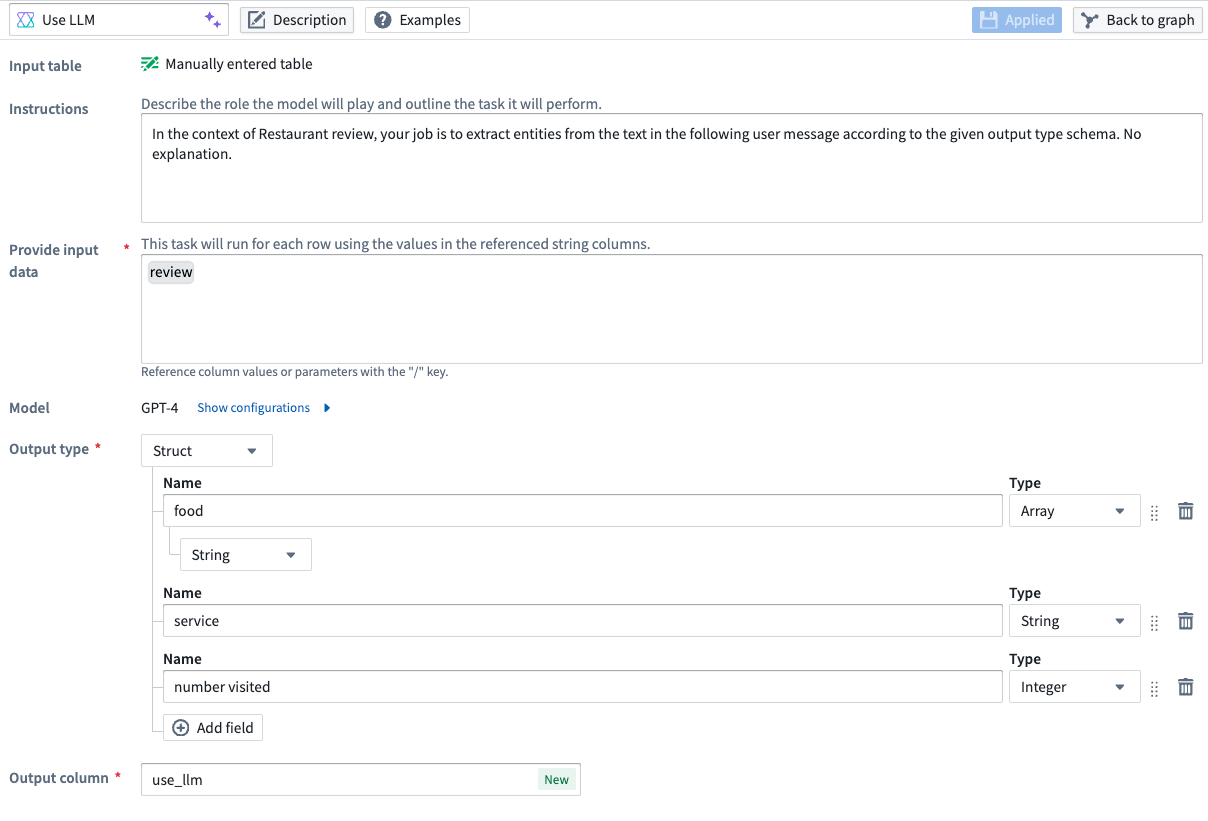
Example of a struct output type containing an array, a string, and an integer.
Learn more about using LLMs in Pipeline Builder from our documentation.
Sync real-time data with Ontology streaming
Date published: 2024-05-15
Put operational data in front of users in seconds with Foundry's new Ontology streaming capabilities, now generally available.
Object Storage V2 now supports creating objects backed by streams as input datasources. By departing from the batch infrastructure used for non-streaming datasets, streams enable indexing of data into your Foundry Ontology in seconds to support latency-sensitive operational workflows.
You can now configure object types with stream input datasources directly in Pipeline Builder or Ontology Manager, similar to other Ontology object types.
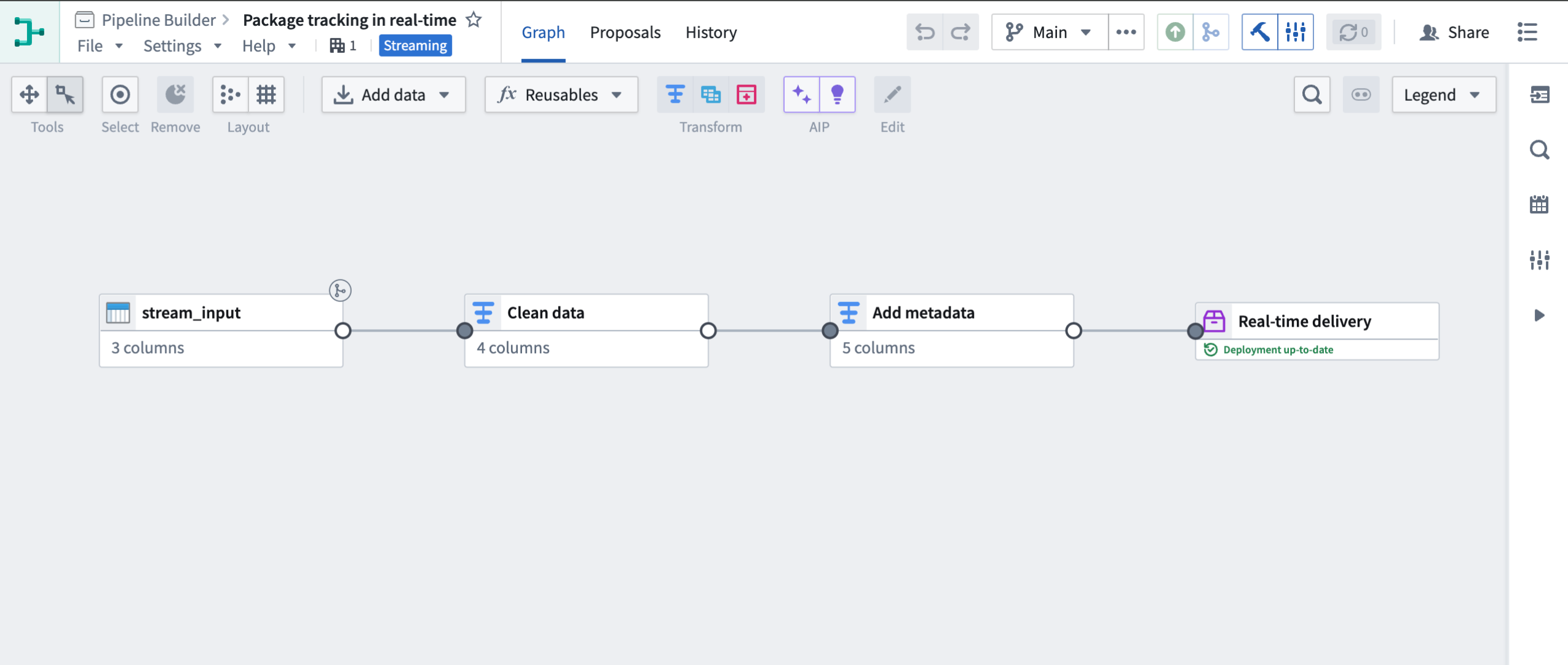
Configuring a streaming object type in Pipeline Builder
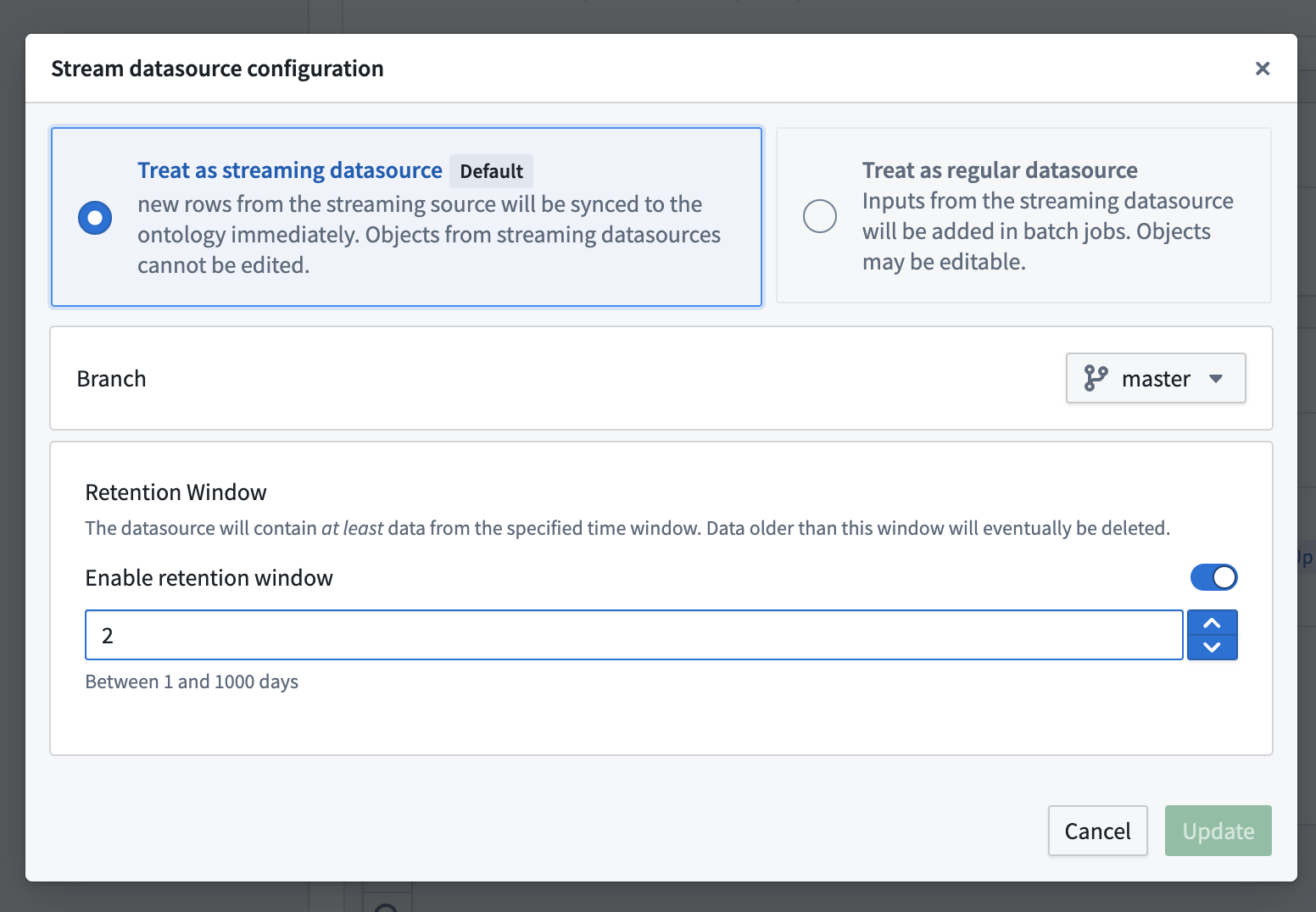
Configuring a streaming object type in Ontology Manager
If you do not yet have a stream configured, you can create one by integrating with an existing stream in Data Connection or by building a streaming pipeline in Pipeline Builder. See the indexing FAQ to learn more about how streams are indexed.
Learn more about setting up a streaming sync and the architecture of a streaming pipeline.
Introducing Upgrade Assistant Prompts
Date published: 2024-05-15
We are happy to introduce Upgrade Assistant Prompts, available now on all enrollments. Starting today, where a resource is impacted on the Palantir platform, you will start to see prompts indicating "This [resource] is affected by an ongoing upgrade".
The new feature enhances the visibility of impacted resources during Palantir platform upgrades by directly highlighting them to assigned users.
What does this mean for you?
Starting today, if you are assigned a particular resource that is impacted by an upgrade tracked in Upgrade Assistant, you will be able to see this information directly within the platform as showcased in following screenshots. This feature ensures that:
- All resources are addressed during an upgrade: You will no longer have to worry about missing out on critical resources during upgrades.
- Improved visibility: Identify and navigate easily through resources that are affected by an upgrade so you can take appropriate action.
Support for Ontology resources is under active development and will be released at a later time.
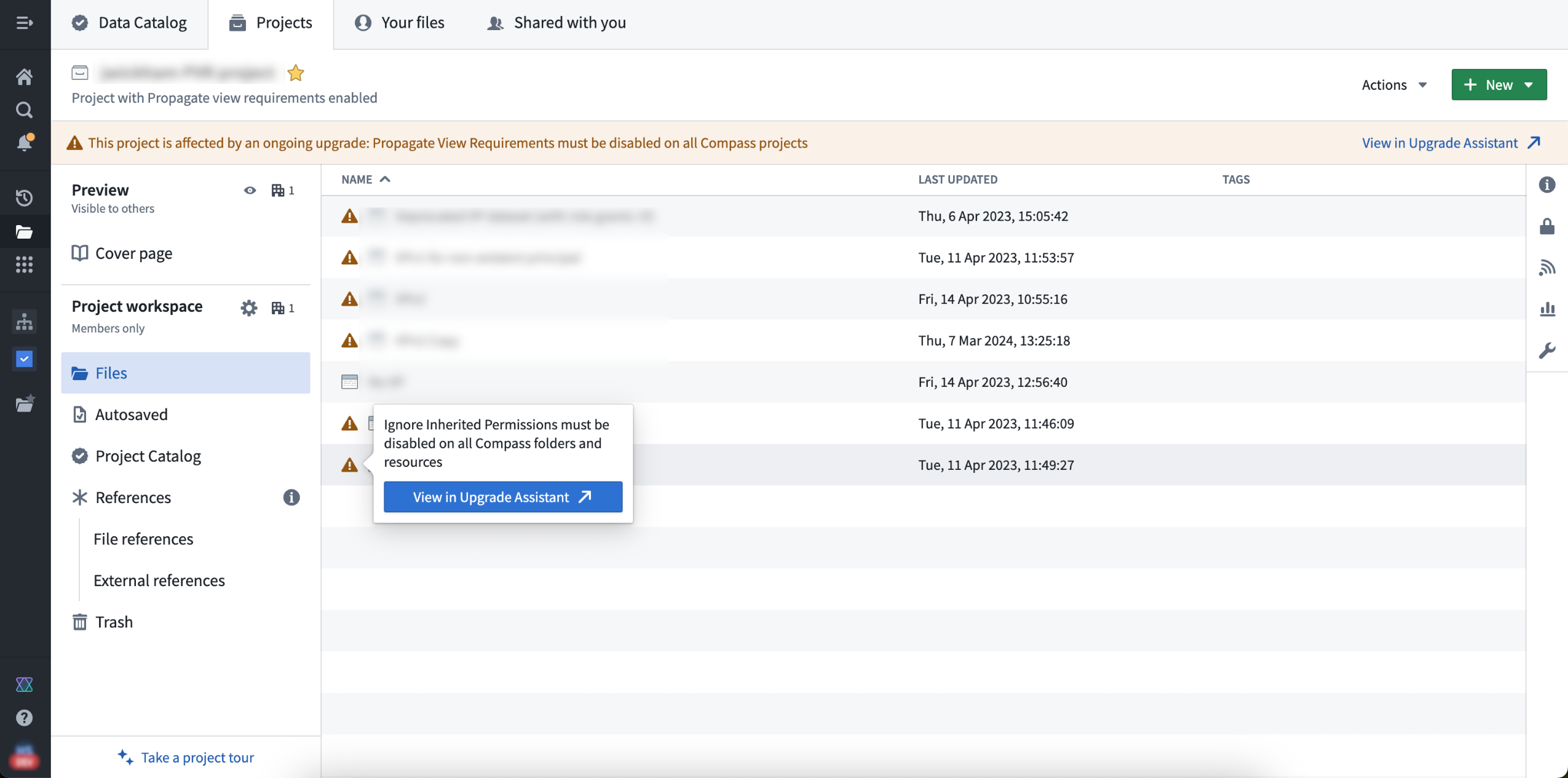
Learn more by reviewing Upgrade Assistant documentation.
AIP model enablement in Control Panel
Date published: 2024-05-09
Enrollment administrators can now use Control Panel to enable groups of AIP models for use. To do so, navigate to the Model enablement tab under the AIP Settings extension.
In Control Panel, models are grouped together into model families based on their legal status and use policy. These model families include both open-source or proprietary models hosted by Palantir, and models provided by Palantir but hosted on Azure, AWS Bedrock, or Google Vertex AI.
Prior to use, the administrator must accept the model family terms and agreements related to usage conditions at the enrollment level. Once a model is enabled, it can immediately be used across the platform on every supported AIP application.
The Model Enablement tab is visible once AIP is enabled in Control Panel under AIP Settings.
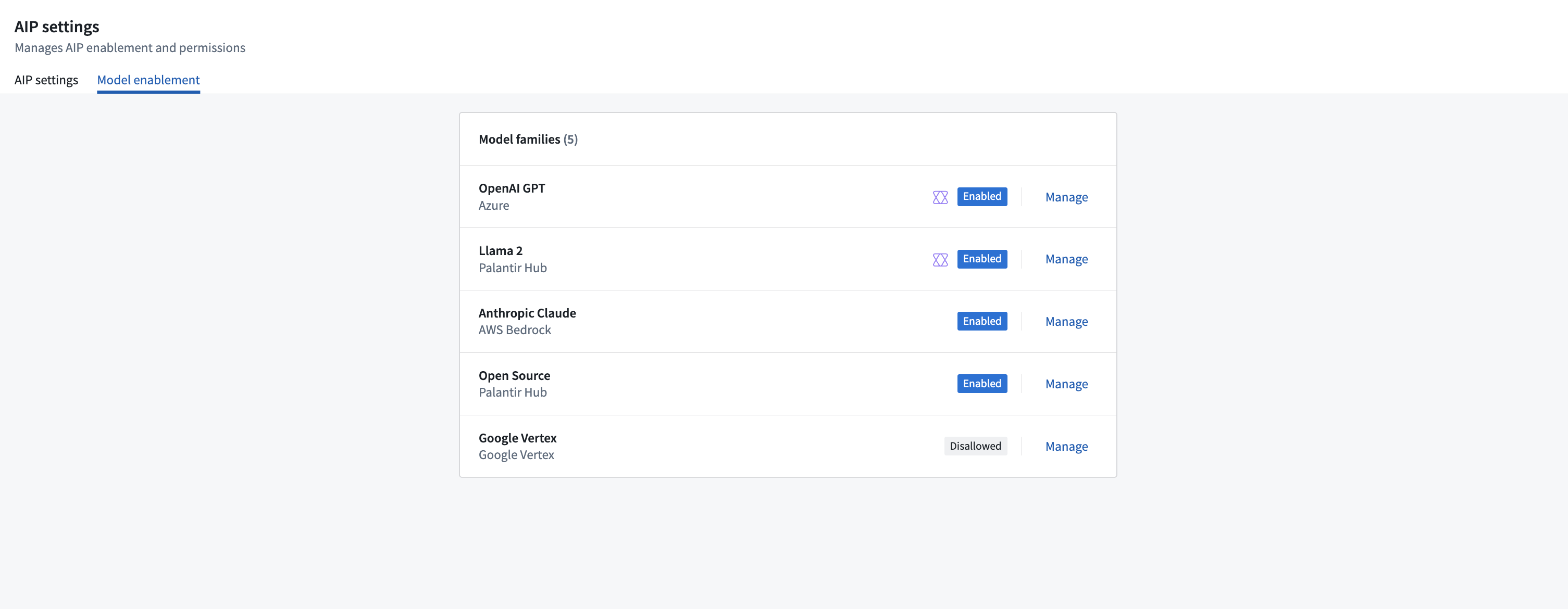
All the model families available for your enrollment, family groups are shown as enabled, disabled, or disallowed.
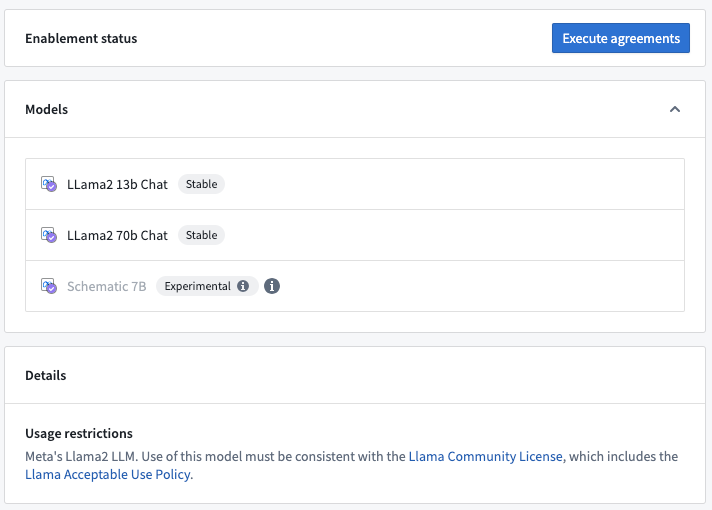
After choosing a model family, you will see all the models available and execute an agreement to enable it.
The Control Panel Model enablement tab under AIP Settings also allows admins to disable models that have already been enabled on that enrollment. Prior to disabling any group of models, consider that:
- Disabling models used for AIP native features (such as AIP Assist, Code Assist) would disable the same capabilities.
- Disabling a group of models would break any workflow that leverages models of that group.
Note that experimental models are currently inaccessible via the Control Panel. Enable the model family first, then contact your Palantir representative for general access. On-premise or specific enrollments interested in activating a new model group must also contact a Palantir representative.
For more information, review the related documentation.
Introducing Preview for external transforms in Code Repositories
Date published: 2024-05-09
Code Repositories now supports Preview for external transforms. Users can run previews for external transforms instead of having to wait for checks and builds to finish running, allowing them to iterate more quickly in the development process. Currently, only external transforms that have no inputs are supported.
To view data and/or files written during Preview, select Preview and then select your output dataset.
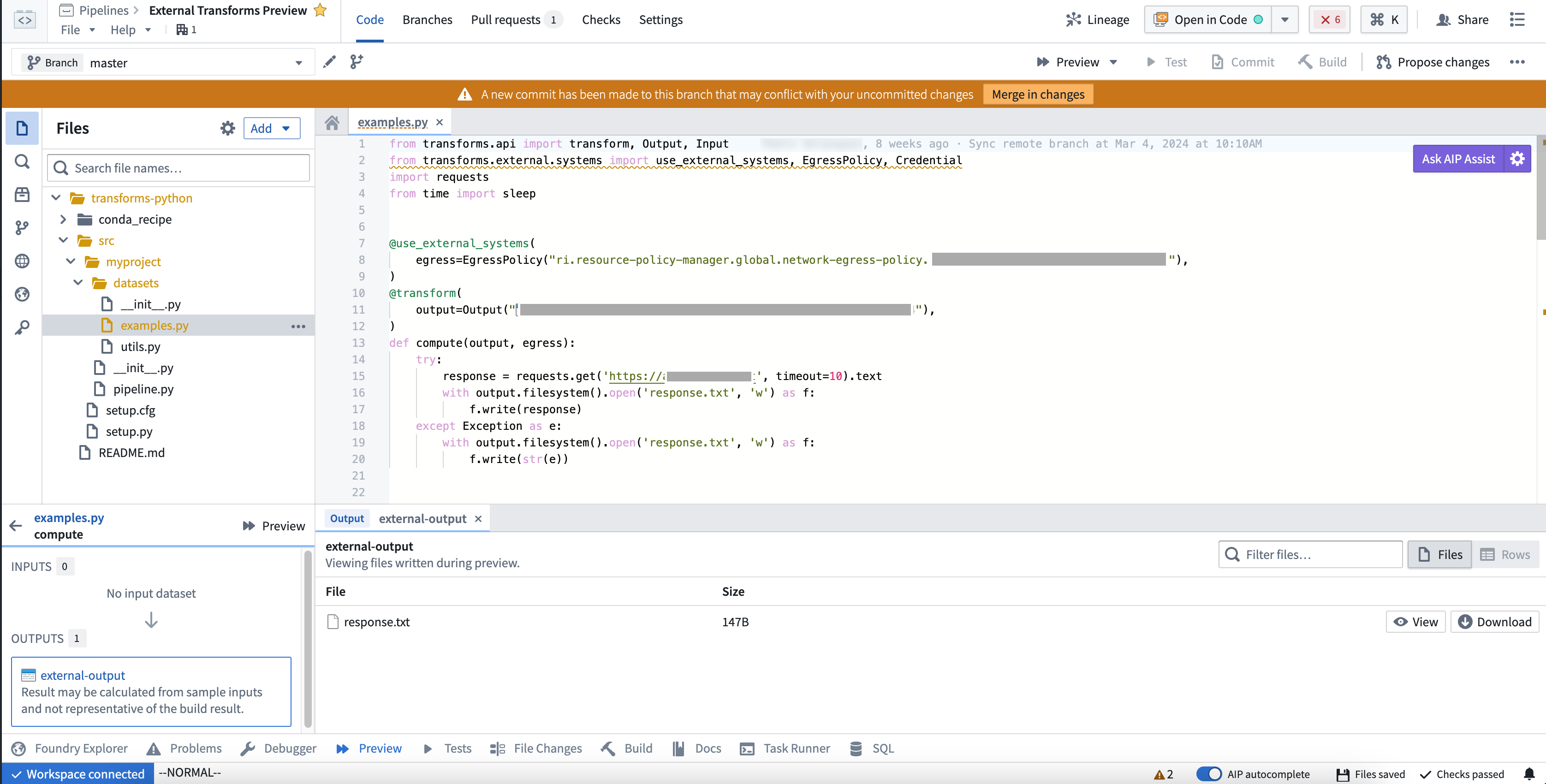
Example Preview on an external transform.
As a next step, we are working on expanding Preview functionality to all input types and also adding support for Source-based external transforms.
Introducing Solution Designer, for designing your business use case [GA]
Date published: 2024-05-06
Solution Designer is an interactive tool for creating architectural representations of solutions built using the Palantir platform, including representations for first and third-party integration points, links to platform resources, on-demand access to documentation and best practices, and more.
Solution Designer is on an accelerated release track and will soon be available for all enrollments at the end of this week.
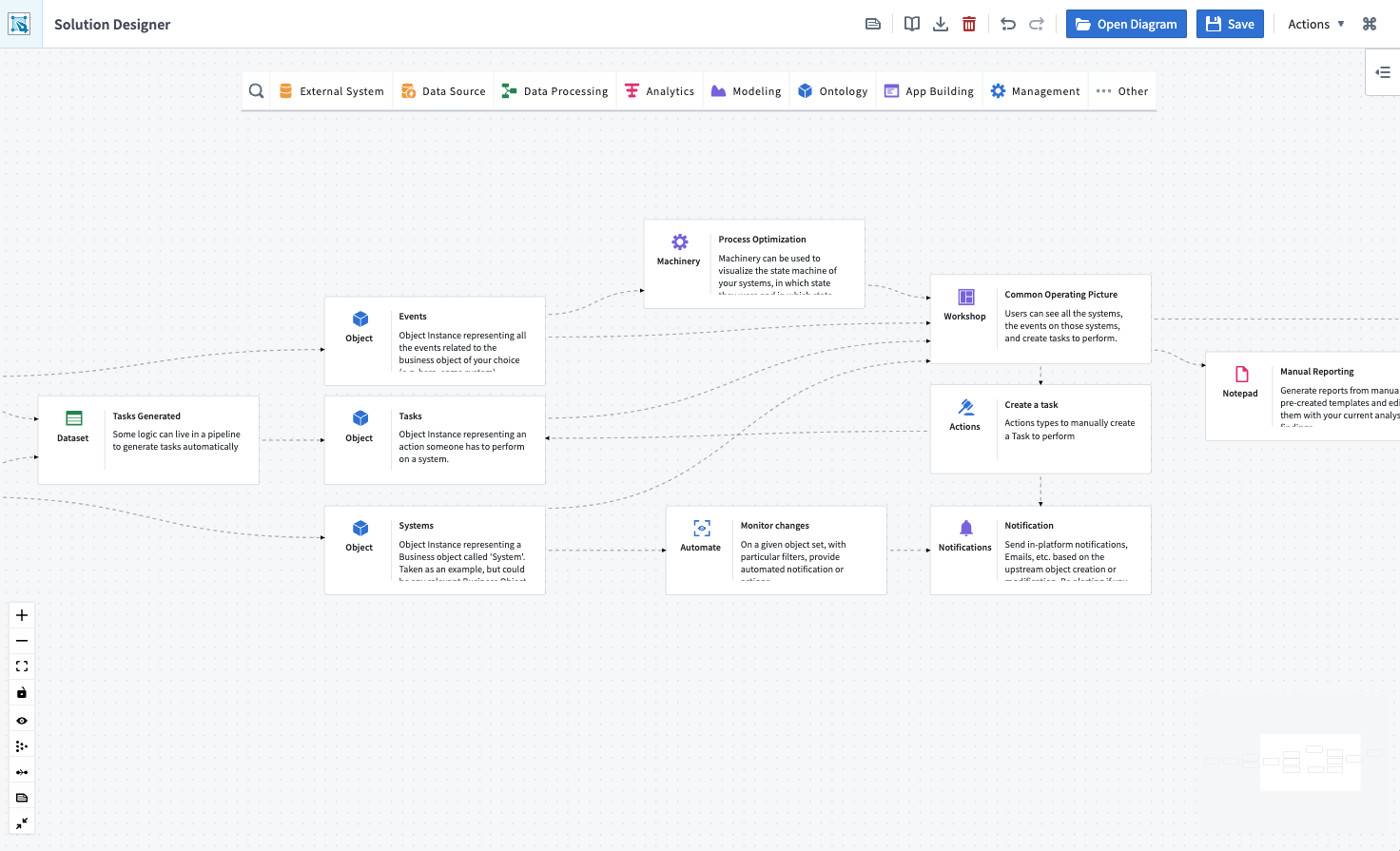
The solution design of a modeling workflow.
Solution Designer allows you to:
- Discover more of the platform: Learn about platform components and how they interact with each other. Explore a curated library of industry and technical reference architectures.
- Architect your solution: Create diagrams from scratch, edit and expand reference patterns, import existing resources, and add comments or descriptions for each step of your use case solution.
- Collaborate and transfer knowledge: Create connections between architectural discussion and specific applications and/or code, actually on the platform. Share solution design along with your project's existing work.
Solution designer is platform-aware, meaning that you can visually interact with nodes that represent Foundry, AIP, and other components, and design solutions for your use cases more effectively.
If you are a platform administrator and would like to disable Solution Designer, navigate to Control Panel > Application access for the correct Organization, then use the Manage option next to the Solution Designer listing and save to restrict access.
Access Solution Designer directly from Files
Solution Designer can be accessed from the platform’s workspace navigation bar or by using the quick search shortcuts CMD + J (macOS) or CTRL + J (Windows). Alternatively, you can create a new solution design diagram from your Files by selecting +New > Solution Design, as shown below.
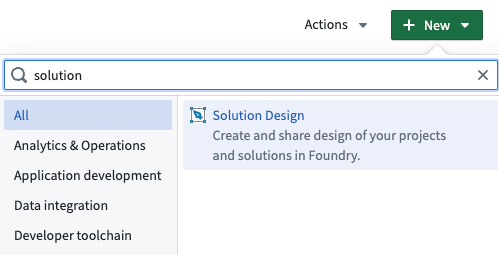
Create a new solution design from your Files manager.
Draw inspiration from a collection of industry and technical patterns
Looking for ideas? You can look through Solution Designer's vast collection of industry and technical patterns to help you get started. Expand from these existing patterns or start from scratch to create the solution architecture for your project and reach a consensus on build plans and strategies that work best for your organization.
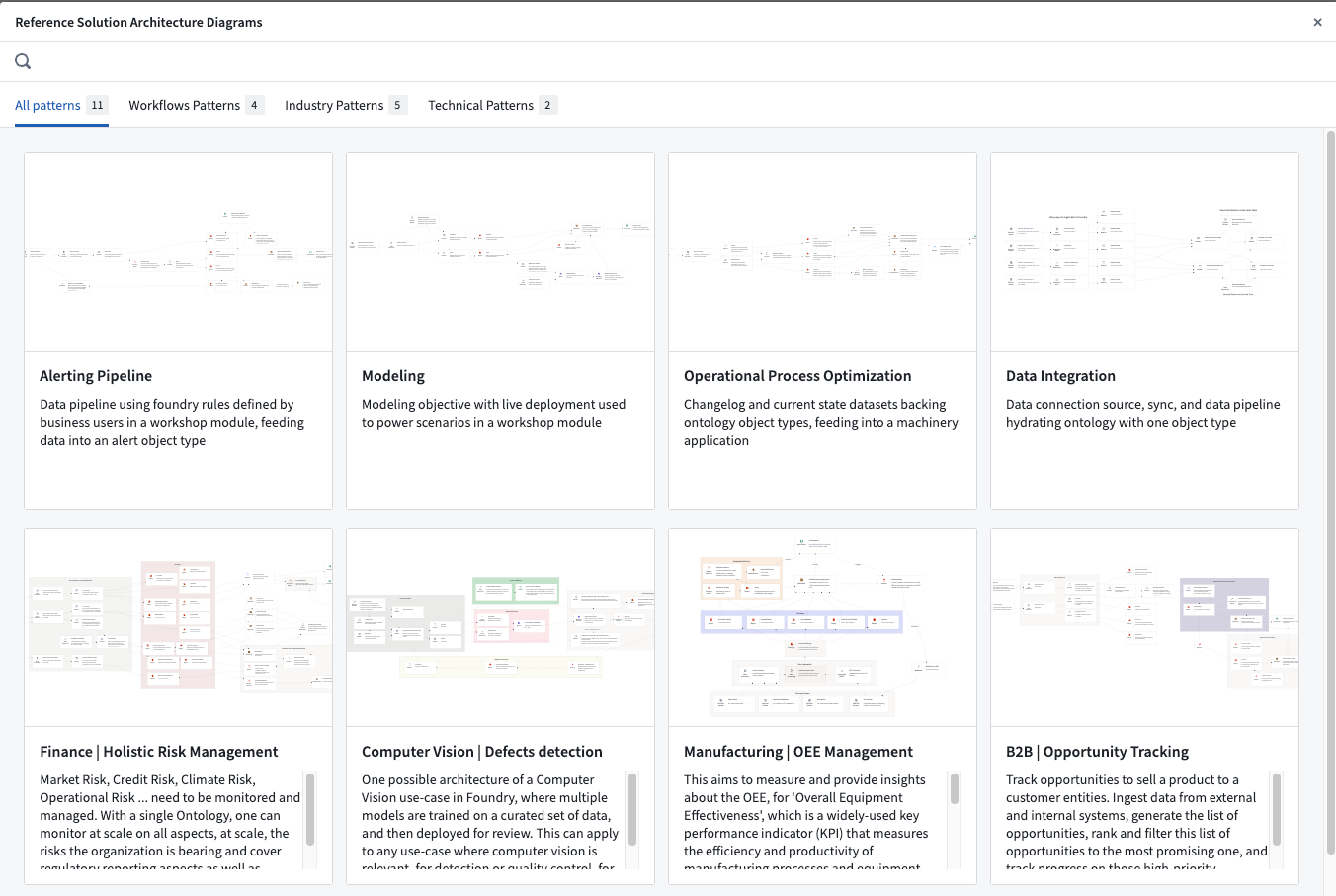
Reference architecture patterns available in Solution Designer.
What's next on the development roadmap?
We are actively working to bring the following features to Solution Designer in the next months:
- Additional workflow guidance and rails to get started
- Resources bootstrapping
- Comprehensive integration with Foundry Marketplace and other applications
Get started with Solution Designer
To get started, review our tutorial on How to create your first diagram.
Otherwise, learn more about Solution Designer in documentation.
Foundry Academy is being sunset, use Palantir Learning and Build with AIP.
As of today, the Academy application has started its sunset period and will be fully deprecated on November 7, 2024. In its place, we welcome you to use Palantir Learning (Learn.Palantir.com), our up-to-date platform for training paths and certifications, as well as new in-platform examples and tutorials to learn about Palantir Foundry.
Palantir Learning is the recommended resource for mastering Palantir platforms. The platform features over 50 courses in various languages and caters to learners from beginners to advanced levels, across specialized tracks like Data Engineer and Application Developer, with new courses added continuously. For users on enrollments without Internet access, this content is also available mirrored in text format through the documentation site.
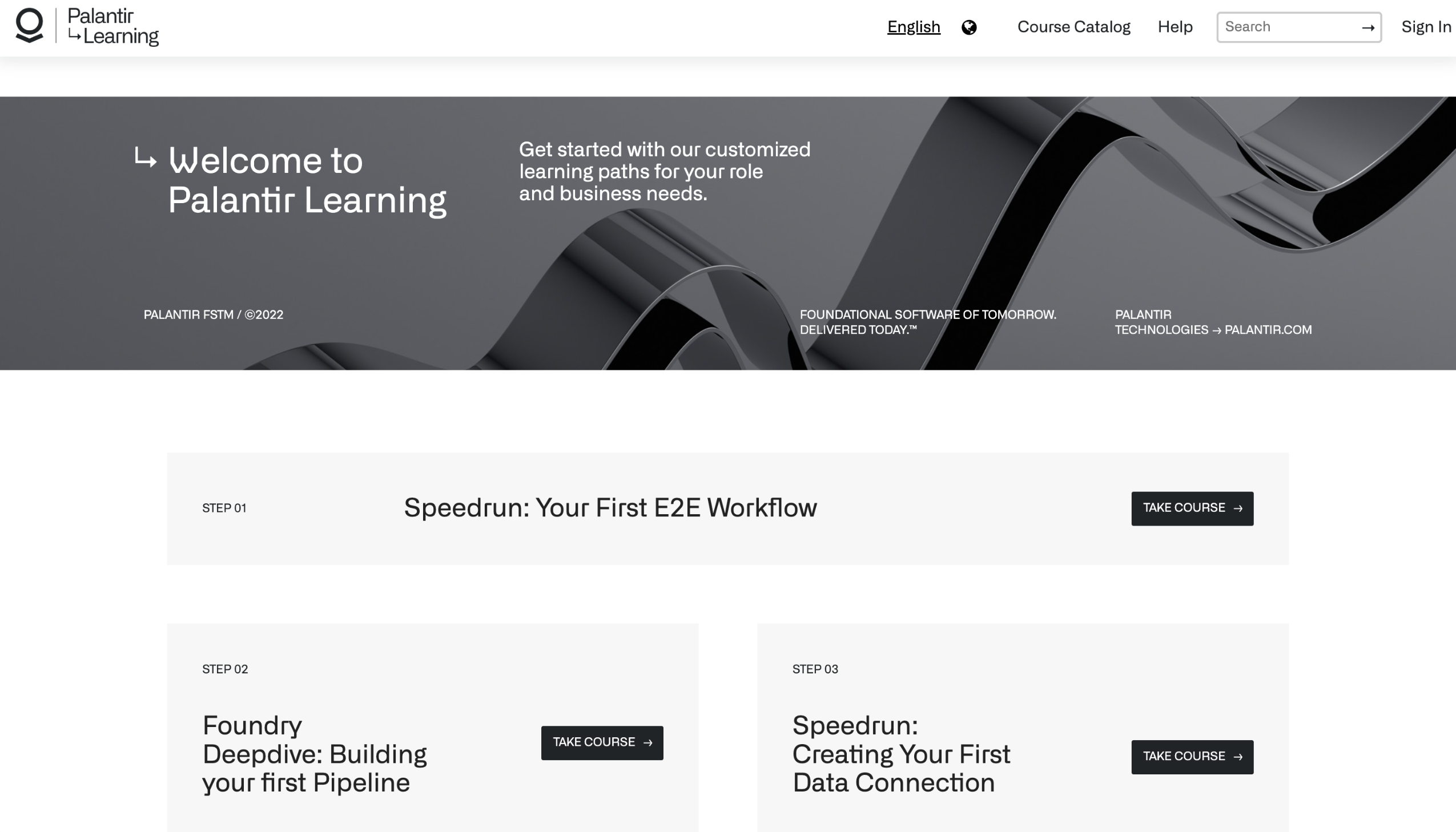
Additionally, you can explore a range of pre-built products available for installation in the Build with AIP application. These products can serve as reference examples, tutorials, or starter packs for builders, adaptable to your specific needs.
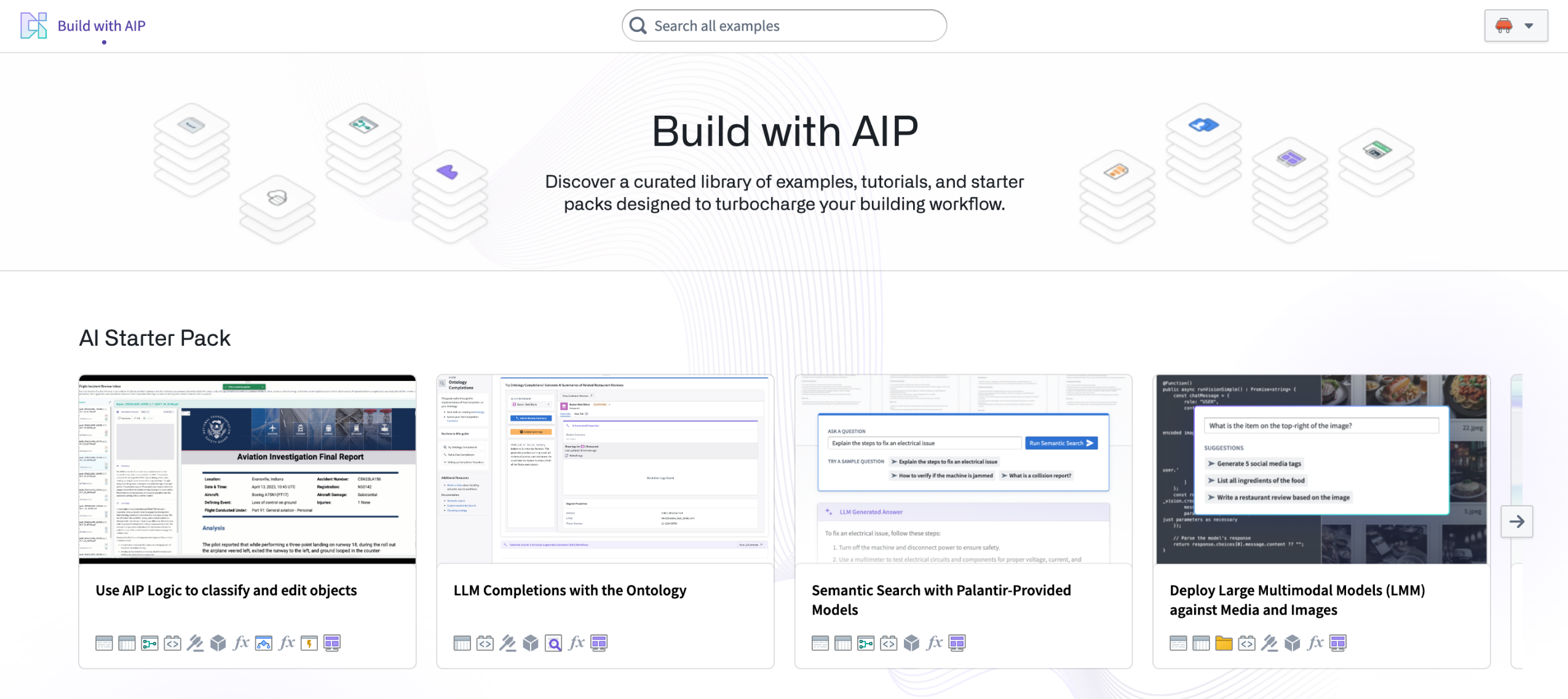
Exciting updates about tutorials in AIP Assist are coming soon for users of the custom tutorial building feature in Academy.
What will happen?
Default Academy tutorials, which have already been redirected to learn.palantir.com for over a year, will be removed imminently. Custom tutorials will continue to be available. When changes occur, we will initiate an Upgrade Assistant intervention campaign to notify impacted customers (those who have created custom Academy tutorials and had active usage in the previous four months) about the deprecation of Academy. For any concerns regarding this transition, contact Palantir Support.
Faster startup times for Ontology Manager
Date published: 2024-05-06
Ontology Manager has been updated to only load upfront the resources that are most relevant to individual users, resulting in a significant performance improvement on startup. From this week on, you can start to experience a faster load time when working in Ontology Manager. No user action is required to activate this enhancement.
The following graph shows a comparative chart of loading times for enrollments with Faster Ontology Loads in green and enrollments (control group) in yellow.
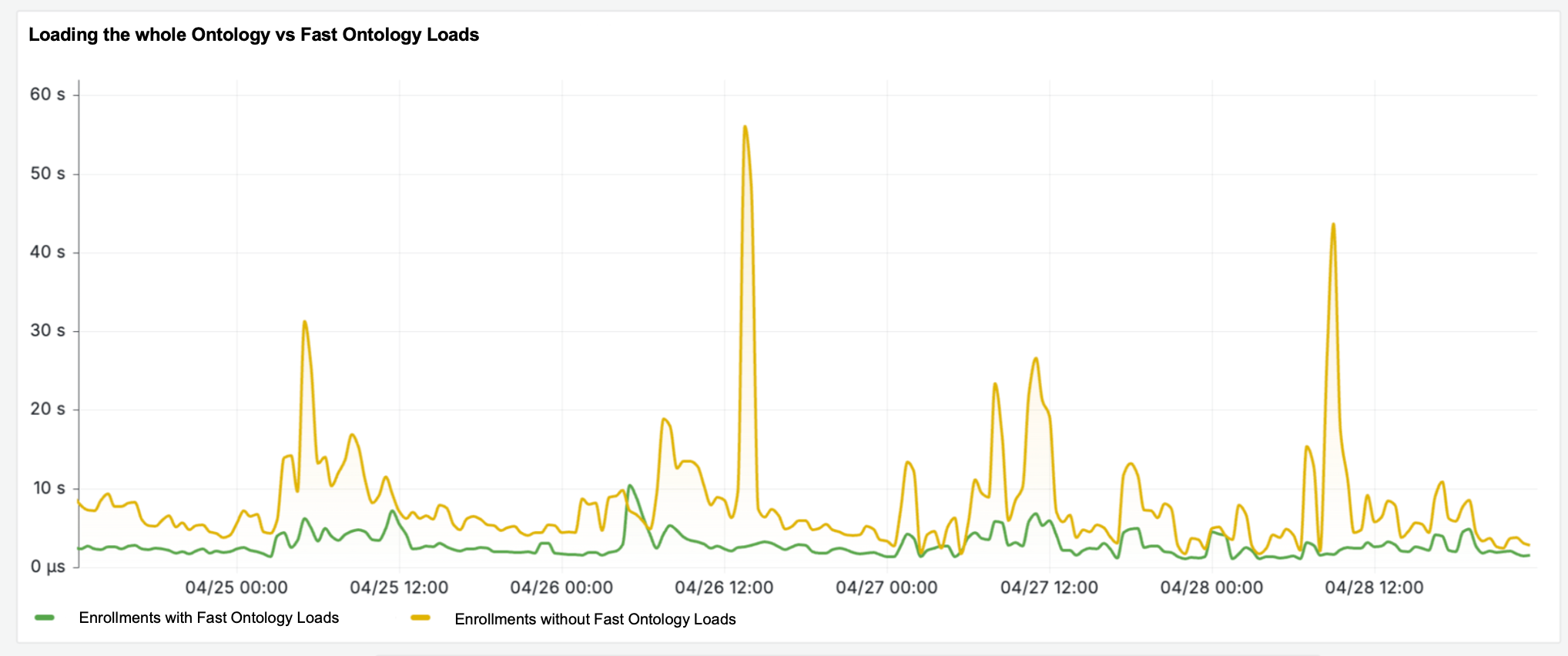
Fast Ontology Loads improve your loading times.
The following workflows benefit from the new Faster Ontology Loads performance enhancement, including:
- Efficient loading of recently-used Ontology resources: You can view or edit your most relevant work faster.
- Efficient loading of Ontology resource queries: Search results are now loaded in batches.
- Quicker access to working state changes: Unsaved changes are now part of the fast load, so you can pick up where you left off without waiting for the full Ontology to load.
- Smoother Ontology switching: Switch between Ontologies before the full Ontology load has completed.
- Faster availability after saves: Ontology Manager is available after a shorter waiting period post-saving.
Additional highlights
Analytics | Notepad
Notepad Resource Header and Toolbar Redesign | The Notepad's UI has been significantly revamped, particularly the resource header and toolbar, to improve usability and organization. Now, elements like collaborator bubbles, web socket connectivity, checkpointing, and the Actions menu are displayed at the top of the document within the resource header. A new View menu has been added to the header, offering user view options such as View checkpoint history and View in print mode. The toolbar now resizes responsively with the web browser and consolidates document editing actions like font resizing, AIP Assist editing, comments, and table configurations. Moreover, various options in the toolbar have been rearranged for better usability.

Introducing a new Map widget in Notepad | Notepad users can now add maps and map templates from the Map app using the map widget, allowing for geospatial visualization creation. Map templates can also dynamically generate map views in Notepad templates by setting inputs with map parameters and providing geohashed object sets.
Analytics | Quiver
Improved Keyboard Navigation in Quiver's Action Selector | The Action Selector in Quiver now supports enhanced keyboard navigation. Users can effortlessly move through options using the up and down arrow keys, and select their desired action with the enter key. This enhancement simplifies the selection process, particularly post-search. Note: Horizontal tab navigation with left and right keys remains unsupported at this time.
Time Series Dashboard Sharing Enhanced in Marketplace | The Marketplace now enables the seamless sharing of Quiver dashboards incorporating time series data. Learn how to use by reviewing Quiver documentation.
App Building | Ontology SDK
Streamlined SDK Integration Experience | A new feature has been introduced allowing users to unveil additional SDK generation insights with a simple click on any SDK generation entry. This enhancement provides in-depth metadata and step-by-step installation guidance, streamlining the integration of the latest SDK updates into developers' local setups. The feature is embedded directly within the Ontology SDK interface, ensuring immediate access to essential documentation and facilitating a smoother development experience.
App Building | Slate
Streamlined Media Set Enhancements | The introduction of a new feature now permits users to effortlessly add new items to a media set from the convenience of the left sidebar, simplifying the update process for media sets that rely on file imports. Moreover, the system now ensures the cache is promptly refreshed post-upload, guaranteeing accurate updates to both the preview and item count.
Improved Query Parsing Notifications in Slate | Slate introduces a new feature for more informative feedback on query parsing errors. The Queries panel now displays a callout in edit mode that outlines parsing issues and offers syntax recommendations for adjustments. The Health Check dialog will now alert users to these issues, aiding in the creation of more precise queries and reducing the likelihood of result misinterpretations.
App Building | Workshop
Workshop Changelog Panel | The Workshop Changelog panel is now generally available. This feature enables builders to visualize changes between workshop module versions. It is useful for tracking modifications made over time and identifying which change potentially caused an issue when debugging problems with the module. Review Changelog panel documentation.
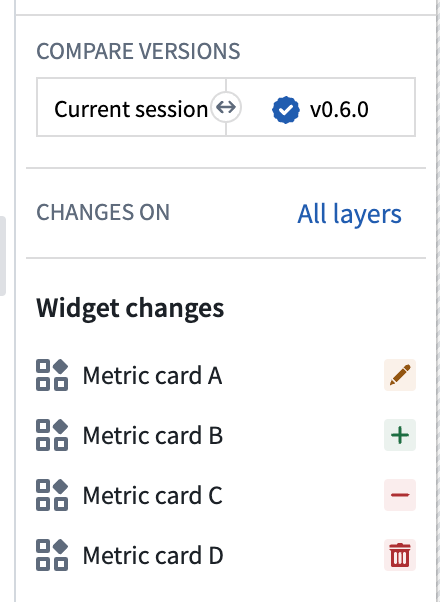
Data Integration | Code Repositories
Expanded Catalog Dataset Input for External Transforms | Foundry's external transforms have been upgraded to support catalog dataset inputs, streamlining the execution of transforms that are designed to operate without inputs or exclusively with catalog dataset inputs.
Data Integration | Data Connection
Refined Egress Policy Submission Process | Users now have the capability to submit network egress policy suggestions, which are then subject to approval or denial via the control panel by an Information Security Officer. Suggestions made directly by an Information Security Officer receive automatic approval shortly thereafter, ensuring that officers can efficiently establish policies. This enhancement democratizes the process of suggesting egress policies, bolstering security management practices. For comprehensive instructions on egress policy management, review the network egress documentation.
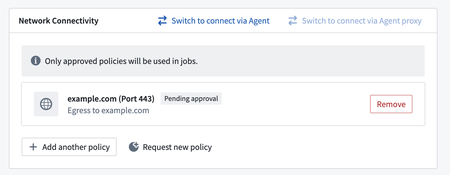
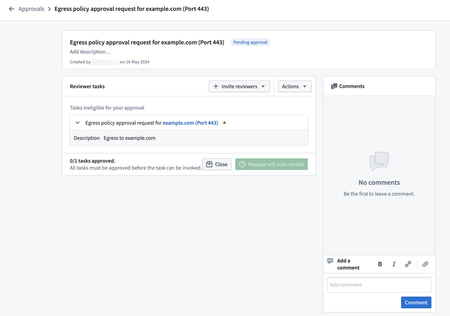
Introducing Databricks Connector [Beta] | The Databricks Connector [Beta] allows Foundry customers to connect to their Databricks environments to ingest data into Foundry for analysis and operations. The connector supports accessing both Unity and non-Unity Databricks Catalogs. The connector currently supports both batch and incremental ingests. We are actively developing capabilities for Exports and Virtual tables. For more information, review our Databricks Connector [Beta] documentation.
*Databricks™ is a trademark of Databricks, Inc.
All third-party trademarks (including logos and icons) referenced remain the property of their respective owners. No affiliation or endorsement is implied.*
Improved Multi-Identity Display in S3 Source Connections | Users can now access and view up to 15 cloud identities within S3 Source Connections, assuming they possess the necessary permissions and multiple identities are present. This enhancement broadens the visibility of cloud identities, allowing users additional credentials for their S3 data sources.
Revamped Visuals on Data Connection Entry Page | The entry screen for Data Connection now showcases card imagery, enhancing both the informational value and visual appeal for users.
Data Integration | Pipeline Builder
Streamlined Data Input via Enhanced Popovers in Pipeline Builder | Pipeline Builder interface has been upgraded to include advanced popovers for streamlined manual data entry within tables. This update simplifies the process of inputting intricate data types like timestamps, dates, arrays, binary, structs, and maps. By typing or double-clicking on a cell, users can now access a more intuitive interface that guides them through the precise input of data.
Streamlined Ontology Output Transformation | Users now have the capability to seamlessly transition object type outputs to dataset outputs within the primary Ontology type output editor in Pipeline Builder. This enhancement grants comprehensive editing privileges for object types using the Ontology Manager.
Streamlined Preview Enhancement with Custom Filter Expressions | The latest update to Pipeline Builder introduces a custom filter expression feature, streamlining the preview process by allowing for the application of user-defined filters. This enhancement facilitates a quicker and more effective identification and resolution of data inconsistencies by enabling filter application across various stages of the pipeline, thus optimizing the time spent on troubleshooting data quality issues.
Intuitive Output Assignment via Context Menu in Pipeline Builder | Using the context menu by right-clicking on a node within the Pipeline Builder now specifically allows for the assignment of an output to job groups when an output node is highlighted. This update enhances the user interface by making the assignment action context-sensitive, directly correlating with the user's selection of an output node, thereby streamlining the workflow within the Pipeline Builder.
Model Integration | AIP Logic
Consolidated AIP Logic Uses panel | Users can now directly observe downstream usage of functions within AIP Logic files, enhancing the ease of tracing function impact. This new feature reduces the number of clicks required to create a new action backed by a AIP Logic function from 12 to four.
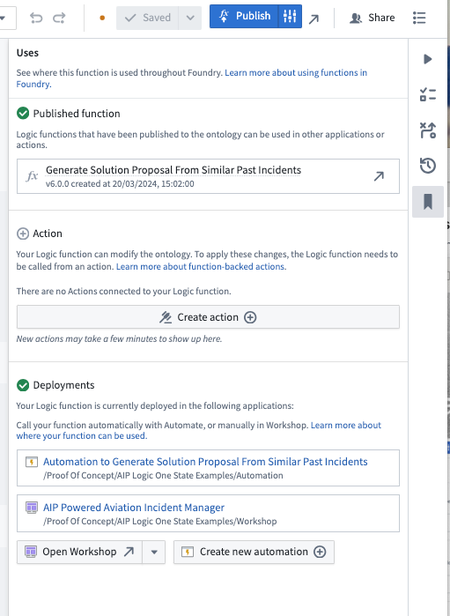
Introducing Object links in the Query Objects tool | The query objects tool can now traverse object links. To use this feature, open an LLM block, navigate to the Query objects property selector, and select the link types and objects you want your LLM to access.
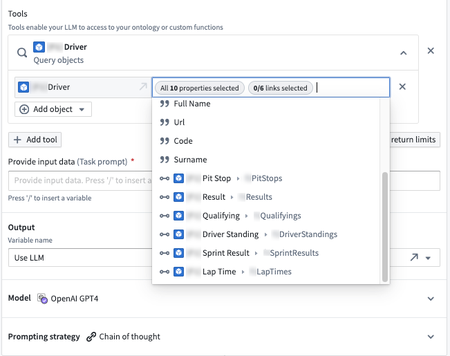
Introducing Object links in the Query Objects tool | The query objects tool can now traverse object links. To use this feature, open an LLM block, go to the Query objects property selector, and select the link types and objects you want your LLM to access.

Consolidated AIP Logic usages panel | Users can now directly observe downstream usage of functions within AIP Logic files, enhancing the ease of tracing function impact. This new feature reduces the number of clicks required to create a new action backed by a AIP Logic function from 12 to 4.

Ontology | Ontology Management
Flagging Unassociated Properties in Ontology Manager | Ontology Manager's Properties tab now highlights properties that are associated with non-existent datasource columns. This enhancement simplifies the process of spotting and cleaning up these unassociated properties.
Streamlined TypeScript Code Synthesis in Ontology Manager | Ontology Manager now streamlines the creation of TypeScript code, enabling users to effortlessly transform simple actions into executable scripts. This advancement facilitates the creation, modification, or removal of links and objects by auto-generating TypeScript code snippets from defined actions. Designed to reduce the TypeScript learning curve and promote interactive learning, this feature eases the transition from action-based to script-based customizations.
Security | Projects
Enhanced Project Folder Callouts | Intervention callouts are now highlighted within the Project folder view, offering users immediate access to pertinent project-related information.
Improved Resource Import Functionality | Import requests for resources can now be initiated by users lacking the import-from operation permission, effectively broadening access to previously restricted resources.